 By Pepper Parr By Pepper Parr
BURLINGTON, ON November 24, 2011 – If you are one of the at least 25 people who actually watch City Council meetings on Cogeco Cable you will hear the Mayor explain that “the heavy lifting” on the city`s business is done at the Council committee level – which are not broadcast live only on line a day or so after the meeting.
The three committees are:
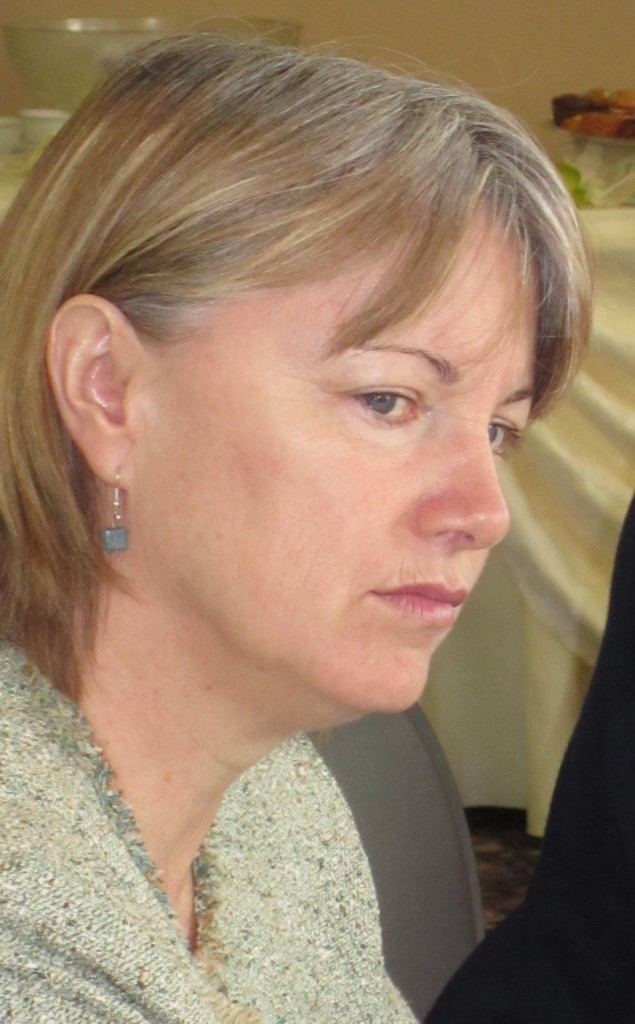 Kim Phillips, General Manager Budget and Corporate Services, is the strongest administrator at the GM level and has the deepest experience on the technical stuff that makes the wheels turn at the department level. Budget and Corporate Services
Kim Phillips is the General Manager who heads up this arm of the city’s administration. The current chair is Paul Sharman of Ward 5, with John Taylor of Ward 3 as his vice chair.
Community Development
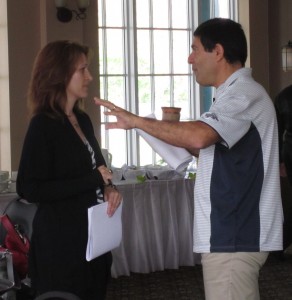 Steve Zorbas, General Manager, Development and Infrastructure is not yet a fully tested GM and still has "Acting" in front of his title. New City Manager will have to determine what to do with the title or with the person. Here he speaks with Ward 2 Councillor Marianne Meed Ward Steve Zorbas, Acting General Manger of Development and Infrastructure leads the charge for this Committee, which is chaired by Jack Dennison of Ward 4 who is backed up by Marianne Meed Ward of Ward 2.
Community Services
Scott Stewart is the General Manager who heads up this arm of the city administration. The current committee chair is Rick Craven of Ward 1 with Blair Lancaster of Ward 6 backing him up
Each year a new chair and vice chair are voted in by the members of city council. Staff, who sit on the other side of the council horseshoe shaped table, just sit and watch and then figure out how they will deal with the new chair voted in.
They got a bit of a jolt when Paul Sharman was given Budget and Corporate Services last December and he kept surprising everyone with a bold, aggressive stance on many issues and some suggestions that had both his colleagues and staff gulping. He has slowed down a bit and we will hear less from him now that he has been voted in as the vice chair of the Community Services Committee.
Last year we had:
Craven heading up Community Services; Sharman headed up Budget and Corporate Services and Dennison headed up Community Development.
This time out it is going to be different:
On motion, Councillors Meed Ward and Dennison were elected as Chair and Vice-Chair, respectively, of the Community Development Committee, effective December 1, 2011 for the term to expire November 30, 2012.
On motion, Councillors Craven and Taylor were elected as Chair and Vice-Chair, respectively, of the Budget & Corporate Services Committee, effective December 1, 2011 for the term to expire November 30, 2012.
On motion, Councillors Lancaster and Sharman were elected as Chair and Vice-Chair, respectively, of the Community Services Committee, effective December 1, 2011 for the term to expire November 30, 2012.
This is a much different line up. Dennison was never a very effective chair; Craven is the best chair the city has and was asked to take on the role of chairing Budget and Corporate Services by the Mayor. Meed Ward, who can be contentious, will likely spend the holidays poring over the Procedural By-Law, something Sharman never managed to do. It is going to be very interesting to see how Meed Ward manages herself; how executive she is able to be. This will be the first time that she has a task that she can actually lead on – and perhaps show some of the other Council members how a “real” chair does the job. It could well be a bit of a defining experience for her and finally give her the opportunity to spread her wings beyond her ward in a way that doesn’t offend other Council members the way it has in the past.
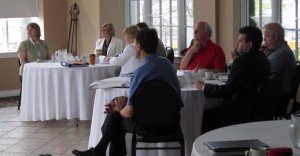 Lancaster of Ward 6 is still developing her personality as a Council member. Being given a committee to chair is a good administrative move. That the chairs were "elected" by their peers is a bit mis-leading. The Mayor has his fingerprints all over this process. Lancaster will have her hands full as a chair. She is not a strong administrator but she has a strong General Manager to support her. It will take a couple of meetings to see how Sharman settles into a much, much lesser role. There was some surprise around the horseshoe when the Mayor put Sharman`s name forward as the vice-chair of a committee that will not have that strong a chair.
This isn’t intended to suggest Lancaster doesn`t know what she is doing – she tends to focus on values and doing the right thing, which is not always evident in some other members of Council. Managing a committee, especially one that interacts as much as it does with the different communities will be interesting to see.
The Mayor continues to surprise people with his executive talent. Difficult to see just what he has in mind with this new line up, but it is quite clear it is his line up.
City Council will be meeting very early on Monday, November 28th, at a local hotel, to perhaps bring to a close another major staffing shake up which started when the Mayor accepted then City Manager Roman Martiuk’s offer to “step aside” and leave the employ of the city.
The new City Manager selection process is now in it`s final phase – they just might make a final decision at the November 28th meeting. One of the candidates for the job is current General Manager of Community Services, Scott Stewart. Should he be offered the job the amount of time to get up to speed will be decreased considerably and that will bring to the surface some significant problems with the number of people in senior positions with the word Acting” stuck in front of their title.
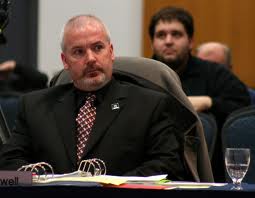 Scott Stewart, GM Community Services: He will never serve as a diplomat - much more of an in charge guy who gets things done. Is he the kind of right hand man the Mayor wants or needs? Stewart is more than capable of doing the job of City Manger – he knows the file and he knows where the bench strength of the management team exists. However, his skill set is not the most important element in the hiring of a City Manager. The relationship between a Mayor and a City Manager is a very tight one; it is almost an intimate relationship and certainly an intellectually intimate one. It is essential that they both be on the same page and that each understands their role. Part of Martiuk’s “stepping aside” was because he wasn’t on the same page as either the Mayor or much of the Council. He certainly wasn’t on the same page as former Mayor Jackson who would claim that Martiuk blocked him at every turn – and with Jackson there were many turns because he didn’t fully understand how municipal government works..
Stewart would never get a job as a member of the diplomatic corps. He is blunt, direct and he gets things done. Appreciate that Goldring will have to decide if Stewart is the man that can help him achieve his dream, vision and hopes for the city. Is he too strong a personality or is his strong personality just what the Mayor needs ? That is something that will get worked through in the interviewing process.
However the Mayor is just one of seven votes – this has to be a majority vote and given the way Goldring works he will look for a unanimous vote. Appreciate that there is at least one member of Council with aspirations to become Mayor in the future and perhaps two. They will look at Stewart and wonder: Could I be Mayor with this guy as the city manager ? They may not admit to such thoughts – but this is politics, never forget that. Politics is about power and the Mayor will want to ensure that he has someone who can help him wield that power.
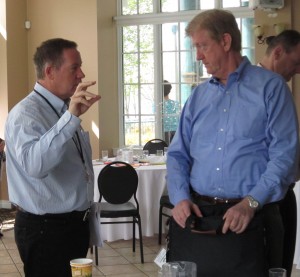 Frank McKeown on the left talking to Councillor Sharman. McKeown was often referred to as the "seventh" council member during the Strategic Planning session, a term that didn't go over all that well with some senior staff but he has served the Mayor exceptionally well. Goldring made an excellent choice in choosing Frank McKeown to serve as his top aide. Goldring would not be the Mayor he is today without McKeown or for that matter without Daphne Jaques. Both fully understand Goldring and are able to take a concept he develops and execute on that concept almost flawlessly. Evidence of that was seen in the speakers that were chosen for the Mayor’s Inspire speakers series. Goldring knew what he wanted, outlined it to McKeown and Jaques and they followed through.
If a Mayor has that kind of support people in place he can get things done. There are still people who use the phrase – he looked like a deer caught in the headlights – to describe the Mayor and, in the early stages of his term of office that is exactly what he looked like – but that description doesn’t apply today.
 Mayor Goldring is in the second phaase of shaping the Council and staff he wants and needs to move forward with his agenda for the city. As collaborative and conciliatory as the Mayoe behaves - make no mistake he has an agenda. Goldring has a very firm grip on his job: likes it, has yet to make a serious mistake, and is loved by the voters. He is in the game for a second term for certain and short of a major, major gaff, and that just isn’t in the cards with this guy, he is in for two terms and perhaps even a third term if that`s what he wants. But that is looking well into the future and crystal balls are very unreliable.
Right now the Mayor wants a city manager that he can move forward with to continue the job he has been doing. The Mayor and his council may well have that decision made before the end of the month.
Then the new City Manager and Council have to deal with the people who have the word Acting in front of their title. Acting Director of Parks and Recreation Chris Glen should have had the word removed some time ago. He has performed well and the person he replaced is on disability and will stay there.
Acting Executive Director of Finance Joan Ford was given the job when Steve Zorbas moved on and up to the job as Acting General Manager of Development and Infrastructure. There are concerns in the minds of several council members about his performance at the Economic Development Corporation and in a number of other areas – so that Acting still being in place could be saying something. Should Zorbas go back to Finance – where does Ford go ? If Zorbas is confirmed – is Ford really on top of the job of senior finance person for the city?
These are questions that will sit on the desk of the new City Manager come January. Know this, your Mayor wants a stronger team running the city and the “stepping aside” done by former City Manager Roman Martiuk might get played out again at other levels. This Mayor can now stare down any headlights coming at him. Still a “nice guy” but now very much a Mayor in charge of his city in a collaborative relationship with his Council.
I don`t think anyone saw this coming last December 1st.

 By Pepper Parr By Pepper Parr
BURLINGTON, ON November 23, 2011 – Will it be tails and white ties? Probably not; but it will be as fancy as dress gets in Burlington with the Celebration opening of the Burlington Performance Arts Centre (BPAC) on Saturday December 3rd. For those women who don’t have a hair dresser appointment – get a wiggle on.
People in the BPAC marketing department are predicting a SOLD OUT of the 700 seats that are going for $400. A pop. And there are no freebies for this one. You buy a ticket and you get a seat.
 Sarah McLachlan has an ability to "caress" a microphone and will enchant the audience at the $400. a seat "Celebration" event. There are, reportedly, a couple of Council members who are not planning on attending. The Mayor will be there – and a few other council members have said they will be in the building – but not all of them.
BPAC reports that they will break even on this event: “It wasn’t designed as a money maker but rather as a ‘celebratory’ event for both the city and the Centre”.
Sarah McLaughlin who does not come cheap and if you want to get a sense of just what she is going to cost multiply the $400 per seat price by the 700 seats and you’ve got revenue of $280,000 – and if it’s a break-even – well you can figure out how much McLaughlin is going to cost.
This event is part of what former chairman of the Theatre Board, Keith Strong said would be a ‘soft opening’. The policy was not to rush into the opening and make all kinds of mistakes. The decision was to take small steps as they worked out the kinks in the building and in the operating procedures. So far, there have been very few significant problems with the building and staff is developing quite well.
Small things, like the look of the web site are getting attention. “They are just little things” explained Marketing manager Hillary Sadler “but they make a difference in to the user experience”.

 By Staff By Staff
BURLINGTON, ON November 22, 2011 Carole Ward, Burlington’s 2010 Civic Recognition Award winner for community service once said that Canada is about to experience a tsunami of seniors and doesn’t think the community is at all prepared for the services and support they will need. “There will come a point”, she said, “ where seniors will need help dressing and feeding themselves and many will want to stay in their homes for as long as they can”, and Ward doesn’t believe the community is at all prepared for the number of people who will need care and support.
This generation of people, known ever since they were born as the Baby Boomers have changed every aspect of society as the moved from pre-school, to elementary, high school and on to university. Now that they are seniors there is no reason to suggest they aren’t going to continue to make waves which Ward calls a tsunami because she believes we are not at all prepared for the demands they are going to make on society. And if this crowd doesn’t get what it wants from its government – they will elect one that will give them what they want.
Keeping active and mentally alert is a part of getting older but there are only so many books you can read and most of the stuff on television is hardly worth the time.
Third Age Learning, Burlington (3ALB) is a new community organization dedicated to offering lecture series to the 55+ community. The inaugural series, An Introduction to Third Age Learning, begins Jan 19, 2012.
 Keeping mentally alert once you're into retirement and away from a job isn't always easy and television isn't going to cut it. A lecture series designed for seniors might be just the ticket for you. We increasingly live in a sound-bite world. The Third Age Learning model, however, offers the opportunity to delve into a topic in breadth and depth. Once the program is underway there will be as many as 8 expert speakers presenting differing perspectives on a single subject. Series 1 is an introduction. Going forward, each series will focus on a single theme.
Registrations for Series 1 is going well, although there are still have a few seats available. 3ALB is a registered non-profit, entirely run by volunteers who are seniors. Third Age Learning, Burlington – 3ALB – is the newest Canadian member of the Third Age Learning movement established in France in 1973. The movement rapidly spread throughout Europe and arrived in Canada, in Sherbrooke PQ, in the late 1970’s.
The audience 3ALB proposes to serve is the 55+ community. Multiple research studies indicate that for this community, preventing cognitive decline is perhaps the best strategy for aging well.
Each presentation series consists of 8 lectures offered over a period of 8 weeks. We plan our inaugural series to run from Thursday January 19 to Thursday March 8, 2012. When the project is fully implemented we anticipate offering two Fall and two Winter series, for a yearly total of 32 lectures.
Each weekly meeting consists of: An information-rich, entertaining, 45-minute presentation delivered by a subject matter expert – a respected economist, for example, or a working actor, a heritage gardener, or a professional historian – typically accompanied by PowerPoint slides or some other visual augmentation
A 15-minute break for coffee, chat, and the opportunity to write a question for the presenter that they hope will result in a lively, often provocative, and always informative Q&A session
Participants should leave with enough information and contacts to follow up on their own, or with friends and family, if they find themselves fascinated by a brand new interest. There are Three Age Learning groups in Guelph, Kitchener that have, for more than twenty years, consistently delivered sold out series to audiences of upwards of 200 members.
Registration fee is $40. For each 8 lecture series – five bucks apiece, less than a cup of coffee and a newspaper.
For registration and more information click here.
For more detail on the program click here.

 By Staff By Staff
BURLINGTON, ON November 22, 2011 – The Halton Regional Police Service have started their holiday R.I.D.E. campaign – and have once again partnered with local students, businesses and community organizations for the sixth year to offer “RIDE 101”, a program designed to educate drivers, particularly young and future drivers, of the importance and responsibility while driving and the consequences associated to mixing alcohol or drugs and operating a motor vehicle.
R.I.D.E. is the acronym for Reduce Impaired Driving Everywhere and was started in 1997 as a program to get control over the then increasing number of drunken driver fatalities on highways. There was a time when Christmas parties in private homes frequently had the host saying “Have one for the road”. Like ashtrays – that phrase has disappeared but drinking drivers have not – R.I.D.E. will be out there in force. If you’re dumb enough to drink and drive – keep your lawyer’s business card in your wallet – you will need it.
High schools from across the Region will be participating in the program. Burlington’s Nelson High will be the participating school December 6th.
 Amazing picture, amazing headache, amazingly stupid - a drunk driver. The official launch will take place at Iroquois Ridge High School, 1123 Glenashton Drive, Oakville, where Halton Police RIDE 101 officers will team up with students from Iroquois Ridge to distribute RIDE 101 educational information, provide students an opportunity to test roadside screening devices and put all students through a series of simulated ‘road side’ sobriety tests during a fun, yet educational format.
The night component will entail members of the student council assisting designated officers in speaking with drivers of stopped vehicles during a R.I.D.E. spot check and distributing ‘Think of Me’ cards and information pamphlets on the consequences of impaired driving. The ‘Think of Me’ cards are hand-drawn and coloured by grade four, five and six students and reflect on that child’s perception of drinking and driving.
The daytime component will be held within the school from 9 a.m. to 1 p.m. and the spot checks will be conducted from 6 p.m. to 9 p.m. out front of the school.
The Halton Regional Police are grateful for the community partners who are supportive of this worthy endeavour, including: the Halton Catholic District School Board, the Halton District School Board, Mothers Against Drunk Drivers (M.A.D.D.), McDonald’s restaurants and Tim Horton’s.

 By Staff By Staff
BURLINGTON, ON November 22, 2011 “A promise is a promise Coach”, were the words that greeted a Burlington parent upon his return from a couple of days in Myrtle Beach getting in some late in the season golf.
Dad had left the kids with wifey and, in an effort to keep the two boys who play hockey less than totally upset, – the boys extracted a promise. “If we win both games while you are away, you have to dye your Movember moustache”. Dad, in an exuberant moment said: ‘It’s a deal, boys”, and loaded the golf clubs into the car and headed for the airport.
Dad had talked a bit about colours, and reached consensus on their pick, not really expecting them to win BOTH games – but they did – 3-1 and 4-2.
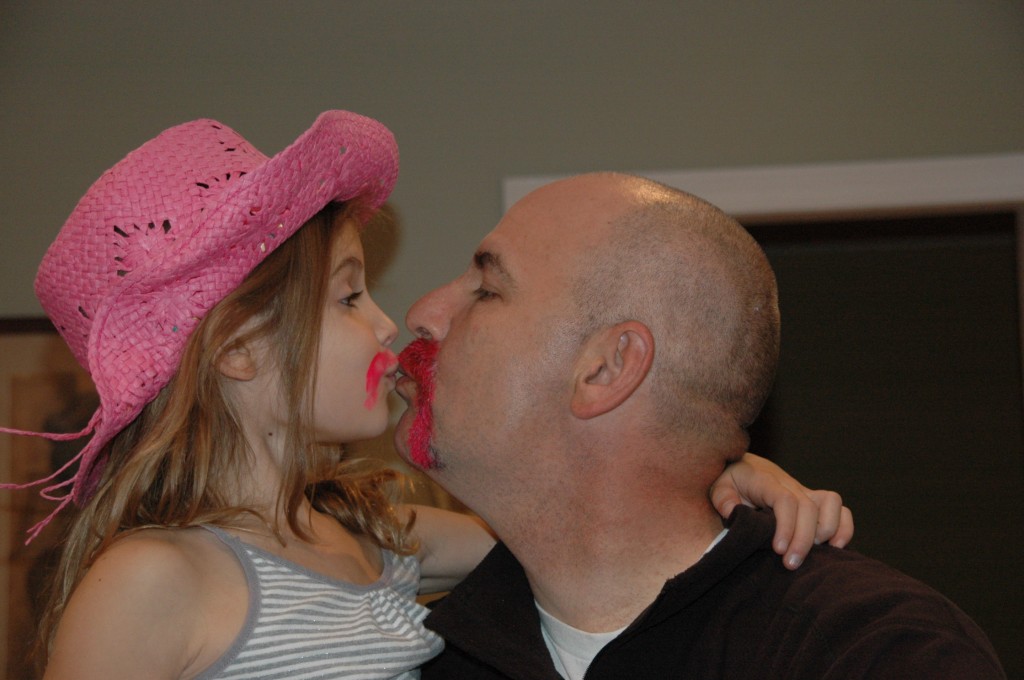 The boys won the bet - the daughter got a kiss and a pink mustache of her own. Dad was off to Shoppers to find a nice shade of hot pink. We don’t know yet, quite what wifey had to say about Dad’s moving into a colour range that is usually hers or their daughter’s.
The man with the “pink thing” under his nose is an Our Burlington columnist who writes about ‘leadership and giving back to the community’. He’s been busy with the boys, the hockey team, coaching, getting in some last minute golf and has fallen a bit behind on his tasks as a scribe.
We are not quite sure what he will be writing – he may have given the phrase “giving back to the community” a whole new meaning. We’ve heard nothing about how the wifey feels about this latest stunt.

 By Pepper Parr By Pepper Parr
BURLINGTON, ON November 19, 2011 – There was a failure to communicate – which can get a little awkward when there are more than 125 people in the room expecting very direct answers to questions regarding heritage housing designations and the people running the event thinking they were there to listen. And that wasn’t easy with a microphone that kept squealing away.
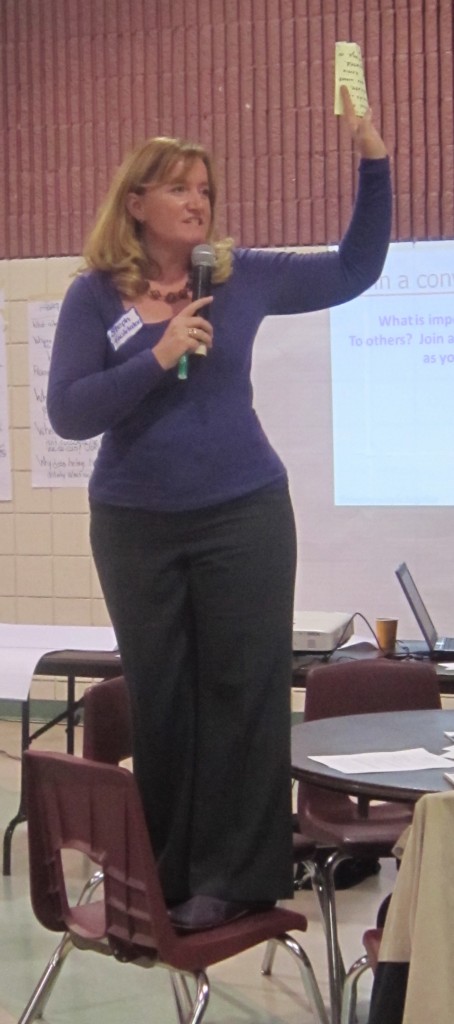 Stephani McCallum, the facilitator imported from Ottawa to lead the community through a Heritage Workshop. She promised to get back to the community within two weeks. Wait for it. The city brought in an outside facilitator, Stephani McCallum of Dialogue Partners, an Ottawa based facilitation consulting firm. She had her hands full for the first hour until she had a clearer sense of what the issue was and then asked the audience to tell her what mattered to them. “Give the process a chance” she asked, and because this was Burlington for the most part she got what she asked for.
In the first hour more than 24 people got up and went home convinced that the city just plain did not want to listen to the concerns of more than 125 people who attended a Heritage Workshop at Mainway Arena last Saturday. Councillor Taylor said that some 200 people registered for the event, but the weather was nice and some may have come up with something better to do with their time.
A survey of 114 home owners was done before the Workshop with the data from the survey used to develop the content for the Saturday event.
There are some 1100 houses on what the city calls an inventory of historically interesting homes. Each of those homes has a designation; either an A,B,C or a D.
There has been massive confusion as to just what the designation means and many people just do not understand why their homes are even on a list. And they were out Saturday morning expecting answers.
“Who started this process” one resident wanted to know? “Can we get some straight answers – right now” another resident demanded.
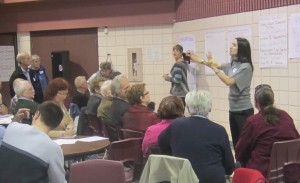 Note takers were busy people as they listened carefully to what home owners had to say about the city’s policy on designating homes. “I am very frustrated with all this” added a third. This wasn’t a crowd of just seniors; it was, if anything more slanted to people in their 40’s who didn’t like what they felt was being done to them.
The city convened the public workshop to educate a public that for the most part didn’t want to be educated – they “just wanted their properties taken off the damned list” as one Ward 4 resident put it.
The others just wanted answers and some clarity.
That wasn’t the mood of everyone in the room but there was certainly a lot of dis-satisfaction for which both the Planning Department and City Council are to blame. Neither have communicated effectively with a public that has been unhappy with the way heritage has been handled by the city. There appears to be some petty bickering going on between a few groups of people with each hunkered down with its position. The greater good doesn’t seem to be a part of the dialogue – and if there is going to be any progress, city council is going to have to face this one directly.
The members of city council – and everyone was on hand – did more listening than I’ve ever seen them do in this kind of a public setting. None of the senior executive people from the staff side of city hall were on hand.
 Home owners at a Heritage Workshop had plenty to say – now the planners have to answer the questions. Within two weeks? McCallum assigned a “note taker to each table” (there were about 20 tables) and had people talk about what they wanted and write it out on a small piece of paper that got put up on a wall. McCallum then sorted the questions, complaints and angst into different groupings and then explained that a table would be set up for each grouping to discuss the questions. There was no one on hand to give answers – it was just a gathering of the questions.
There were six groupings – but the one that mattered to most was Property Rights and Values. Listing process, Listing criteria, Legislative responsibility and Criteria for a designation and Solutions were the other five.
 Councillor Taylor works at listening to home owners who don’t like the city’s historical recognition policies. The note takers were for the most part city hall staff who had volunteered for the day to be on hand. Other than the free sandwiches at lunch, all they got was a thank you from the council members. There was no round of applause for these people who did some very hard and at times exasperating work. It was not Burlington at its best.
The home owners wanted input. They were for the most part very confused. One Ward 2 home owner said he felt he should have gotten a letter city telling him, what the designation on his home was, why it was given that designation and then an opportunity to decide if he wanted his home on the inventory. Most seemed to believe there was a place for heritage recognition but didn’t feel there were 1100 homes in the city that merited historical recognition.
One wag spoke of a neighbour whose house had been designated. He sent city hall a registered letter asking for confirmation of the designation and if the house was on the designated heritage property list then he wanted it taken off. That was seven months ago and he hasn’t heard a word from anyone at city hall.
Then there was Donna who was very vocal at the start of the meeting and had this to say at the end: “I got what I needed to know, but I don’t think anyone else did. I got answers, because I asked very deliberate questions of specific people. This could have been put up on a Power Point, and we could have all gone home.
Another resident had no idea how his house got put on a list and felt “the city should have no say with what we do to our homes”. At no point during the workshop did any one plead for the need to recognize and preserve historically significant property. Yet whenever anyone suggests the smallest change to the Paletta Mansion on Lakeshore Road all hullaballoo breaks out – so at some level history matters. Is Burlington the kind of city that says history matters but I don’t want to pay for it and don’t apply any of the rules to my property? Is that why the Freeman station sits close to rotting beside the fire station on Fairview Street?
 Councillor Dennison lets home owners bend his ear. He did however speak up for the historical designation of homes. If that’s the case – this city has some growing up to do.
The home owners wanted input – and they weren’t shy about telling the note takers what they wanted..
A voluntary process – not someone deciding arbitrarily that a home was on a list.
No unilateral decisions..
Tax breaks for homes that are put on a Heritage registry
What have other municipalities done?
If a houses is going to be designated the city has to meet with the homeowner and the neighbours..
Wipe out the lists and get rid of the Registry.
Remove any authority from the Heritage Advisory Committee.
It was mid-day and time for lunch. Sandwiches and soft drinks were laid out on tables and the room was suddenly very quiet. It was almost like a large barn where the cattle, having been fed were settling in for the night chewing away on their cuds.
Stephani McCallum promised the audience she would get back to them with a report in two weeks – it is going to be very difficult for her to complete the massive task in front of her and, she will not report to the community. She will report to the Planning department who many feel is the group that created the problem in the first place. Planning will, according to Stephani, answer all the questions she sends along to them. For the citizen waiting more than seven months for a reply to a registered letter this will indeed come as a surprise – but that was her undertaking.
You could feel the event winding down. McCallum asked people if they wanted to continue talking – please do so – very few did – this road show was over.
 The note takers worked with facilitator Stephani McCallum, on the left. All the note takers were city hall staff volunteering their time. The Planning Department will go through everything the facilitator sends them and get back to the appropriate City Council committee with some recommendations. Given the ear bending every council member had to put up with on Saturday – Council just might pre-empt the Planners and come up with a Staff Direction to the Planners.
McCallum will first get back to the community with what she heard and promised to do that within two weeks. Part of the “what she heard” will be to set out all the questions which she then understands the Planning Department will answer – THAT will be a feat and a half. We say that because for the most part Planning has already answered all the questions and yet there are still people who are very unhappy – so somewhere there is a failure to communicate.
McCallum understands the passion people have for their homes and she has found that the higher the passion the greater the opportunity to explain and resolve difference.
McCallum’s work will go to the Planning department where the questions she passes on will get answered – with the answers being put up on the city’s web site (And good luck in navigating that bucket of information.) Surprisingly, McCallum, who was brought in to facilitate a public meeting on one of the thornier Planning Department problems but didn’t get to the meet with the Planner, Bruce Krushelnicki. One would have thought that an issue that has such a high profile would warrant at least a ten minute conversation with the person who was hired to interact with a public in a high profile planning problem. Is this where the failure to communicate lays?
 Councillor Craven may have felt his McMaster jacket would ward off some negative comment. Don’t think it did – every member of Council had their ears bent by the 125 people who showed up at the Mainway Arena Saturday afternoon. Burlington as a city has to decide what it wants in terms of keeping its history alive. There appears to be a small group that is passionate about what they want for the city and a thousand or more home owners who don’t share that passion and don’t understand, why they are being pushed around. They just want to live in the homes they own, keep them in good repair and be able to sell them if and when they want to sell them. And if they want to put on an addition they feel they should be able to do so.
Burlington doesn’t appear to have a sense of what it’s history is all about and some of that responsibility rests with the Historical Society who clearly have not done their job of informing the public.
We didn’t hear anyone standing up for historical recognition at the Saturday meeting. Ward 4 Councillor Jack Dennison rose to speak during one of the group discussions and explained that a house on Lakeshore Road where he lived had a designation on it which meant a developer could not tear the house down for a period of 30 days – and with that designation he explained we were able to save a historically significant house”.
“At whose expense” came a comment from a table with a group of particularly nasty people who just did not want to listen. “We know what we want” – and it wasn’t a registry or an inventory – they wanted to be able to do whatever they wanted to do with their homes. There was a surprising lack of civility at this particular table.
 Mayor gets ears bent – doesn’t say ouchh. Mayor Goldring spoke close to the end of the meeting and assured those that were left that he was “committed to resolving this problem. I can’t give you a date – but you have my commitment.”
All the politicians met with people one-on-one and let them bend their ears. City Council has a bee that is going to sit inside their bonnet and if something isn’t done – council members are going to get stung.
McCallum in her final report to the city will make recommendations as to the process the city should follow. Based on what I saw at the event at the arena on Saturday – this council isn’t going to wait very long before it does something.

 By Pepper Parr By Pepper Parr
BURLINGTON, ON November 21, 2011 – When someone appears before Council to speak to an issue they are given five minutes to make their point. Jane Irwin, retired book store owner and a one time member of the Heritage Committee told council way back in April, she was there to scotch some rumours and false information about the Heritage Property Registry .
“Watching the recent streamed Community Development Committee meeting,” said Irwin, “I seemed to hear certain misstatements of fact about the Heritage Property Registry – – which I had heard before, and which I hope to set right tonight.
I want to speak to you before your Workshop because untruthful rumors, whatever their sources, can be very difficult to correct, especially if they circulate unchallenged.
 This is a Burlington home on Walkers line that is on the housing inventory and has been given a grade which tells something about the house. That's all the grade does. There is much confusion about the inventory grades and what they mean. Councillors hear a lot from spokesmen claiming to represent about 1/5 of owners of properties on the heritage register. Spokesmen, she added are “not sworn to speak the truth to Council” Luther Holton, Ms Irwin advised, “speaks very well for himself and his mother and needs no spokesman”.
I’d like to scotch 4 of them” said Irwin.
1: Registry was not produced by the Heritage Committee, but by Burlington’s Planning staff, initially professional Planner Marilyn Lagzdins. The Director of Planning at the time was Gary Goodman.
2: Inventory was never produced by summer students. That statement is completely and utterly false. It implies that irresponsible students with no experience, no mature judgment for the job put homes on a list. Not true.
3: There is the belief that the Grades A B C D that were assigned to homes were subjective or impressionistic. Nothing could be further from the truth. The grade assignment criteria were the result of objective evaluations based on meticulously responsible criteria. There were 20 criteria in 5 different categories with a ceiling that could be given in each category. A grade of C represented “ordinary” standard and a grade of D was given to properties for which there was no information. We made an annual presentation of the revised Inventory to Council every year from 1992 until 2001
One of the references used for the development of the criteria was Harold Kalman’s The Evaluation of Historic Buildings and the 1970 Canadian Inventory of Historic Buildings Parks Canada. Click on the link to learn what grades A,B,C and D mean.
The Council Committee meeting was told that the Burlington Historical Society has data on some 80 First Class buildings in the city that are more than 100 years old and there are almost 30 Century Farms in Burlington — living history. Irwin also pointed out that in 1992 the Lakehurst Villa, the La Salle Pavilion and Shore Acres (now Paletta) Mansion were not on the Inventory.
4: There is the hint that Heritage Committee members were unpaid volunteers, amateurs or worse, dilettantes. Heritage Committee members in my experience were lawyers, architects, designers / builders, engineers and planners. People whose ancestors came to Burlington more than 200 years ago.
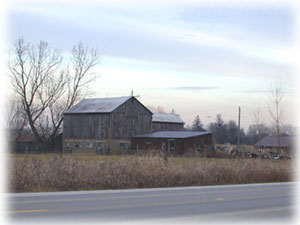 A Burlington farm house - thought to be of historical significance and given a grade on the inventory the city keeps of such properties. To describe the people who sat on that committee the way they have been described is a dis-courtesy to the members of your other volunteer advisory committees
Irwin added that: “Professionals working in Toronto for the Government of Ontario, including one whose responsibility it was to revise the Ontario legislation that has been the most troublesome to property owners, and which has gravely disrespected their right do what they like with their own properties”.
Council got its first primer on what the issues were behind the squabbles over buildings that are on a Heritage Registry. Mayor Goldring was so impressed with her performance that he asked Ms Irwin if she would take part in the workshop session planned to fully brief Council members before a second workshop session takes place with the owners of the homes that are on the Registry. She didn’t take him up on the offer.

 By Staff By Staff
BURLINGTON, ON November 21, 2011 – Are you interested in learning more about the Forensic Identification Unit, the Tactical and Rescue Unit, or the Collision Reconstruction Unit? Are you curious to know what it’s really like to be a police officer? Want to know about fraud and identity theft prevention?
The Halton Regional Police Service still has spots available for the upcoming session of the Citizen Police Academy. This informative and innovative program runs from 7-10 pm every Tuesday night for ten weeks, between January 24th and March 27th.
Each week participants are given presentations on various aspects of the Police Service. Just a few of the areas of the Police Service that are covered include Recruiting, Hostage Negotiations, Major Crime Investigations, Diversity, Police Training Unit, Polygraph, Morality/Drugs, and the Communications Bureau.
 Halton Regional Police offering community, police support training. Application form on the web site This voluntary program is designed for anyone who wants to improve their knowledge of their local Police Service, and policing in Canada in general. Preference is given to persons who reside in, work in, or own a business in the Region of Halton.
Sergeant Kim Hill, Community Policing Support, is the driving force behind this effort. She can be reached at 905 825-4747 x4901 or be in touch with Wendy Gzechowski, Community Policing Support, 905 825-4747 x5042
There is more information on the HRPS web site along with an application form.
www.haltonpolice.ca – click on Community Policing/Public Safety & Education folder.

 By Staff By Staff
BURLINGTON, ON., November. 18, 2011 – Two students at Burlington’s Aldershot High School convinced nearly half the student body to commit to finding an alternate, environmentally friendly mode of transportation to school on International World Car Free Day, which was last September 22. That effort won their school’s Eco-Club, a $250 prize from Burlington Transit’s Youth Ambassador (BT YA) program.
 Carolyn McLarty (Guidance Counsellor at Aldershot High), BT YAs Kayla Peters and Billi Krochuk, and BT’s Sandra Maxwell Kayla Peters and Billi Krochuk are Burlington Transits’ Young Ambassadors at Aldershot High. Their efforts, through BT YA’s Green Monster campaign, resulted in more than 300 students and staff finding eco-friendly transportation to school on September 22, including walking, cycling and taking the bus.
Burlington Transit has ambassadors in several Burlington high schools competing for the $250 prize.
“All the YAs put on great efforts,” said BT’s marketing co-ordinator Sandra Maxwell, “but Kayla and Billi ran a great campaign with great results.”
The program, in partnership with BurlingtonGreen, was launched this fall and encourages students to spread the word that public transit and other forms of environmentally friendly transportation are key to preserving the environment for future generations.
“It’s inspiring to see young people embrace environmental challenges in such a positive way,” said BT director Donna Shepherd. “This group of young leaders will help keep Burlington green and sustainable in the future. We expect this program to grow considerably in the next few years.”

 By Pepper Parr By Pepper Parr
BURLINGTON, ON November 16, 2011 – It was a Community Services Committee meeting; that meant Scott Stewart was on deck and that meant an Update on The Pier. It was short – less than 50 words actually – which meant there was nothing really happening and Stewart suggested that perhaps Pier Updates could be dispensed with. ‘Not so fast laddie’ was the response he got to that idea. Councillor Dennison said there “was significant enough concern” in the community and that putting out the report lets people “at least know there is something going on”. Meed Ward chimed in saying she was supportive of continuing the updates at every second Community Services meeting. “It is not a lack of trust” commented Meed Ward. “Things do happen, things did happen. This is a prudent course.”
Then Meed Ward upped the ante a bit and asked when there might be some information on how much money has been spent on lawyers and what the legal strategy was going to be regarding the Pier going forward.
Stewart, along with Acting City Manager Kim Philips, advised the committee they could expect something at the December 14th committee meeting. Meed Ward wanted more than an ‘expect something’ but the best she could get was that there would be some material on what the strategy should be on releasing information about legal costs but there would be no numbers.
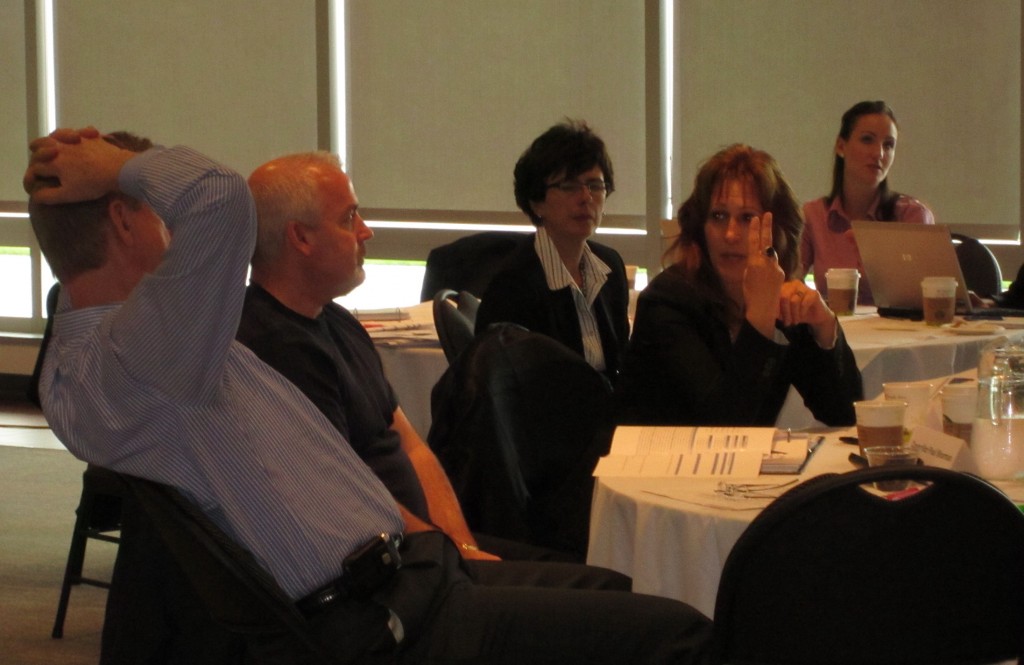 General Manager Scott Stewart on the left and Councillor Meed Ward second from the right (Helen Wallihura in the middle) This is not the last time Meed Ward will be using hand gestures to communicate with Stewart. Meed Ward and Stewart bantered back and forth on what exactly the committee was going to get. “All expenses on the Pier” asked Meed Ward – “No,”, responded Scott Stewart. ” there will be an overview and discussion around a strategy then discussion around the costs.” It was like pulling teeth from a hen. It was clear that staff really didn’t want to talk about this and equally clear that Meed Ward did want to talk about how much money had been spent suing the various parties that were involved with the building of the Pier during what is now called Phase 1.
Staff kept talking about looking for a strategy within which they could then release specific financial data on the Pier. How much are you prepared to bet that much of this “strategy” stuff will get discussed in closed session?
One got the sense that staff (city solicitor Nancy Shea Nicol was not at the meeting) wanted to say as little as possible but that cat was out of the bag and Meed Ward wasn’t going to put it back in.
Ward 4 Councillor Jack Dennison made an important point when he advised the committee Wednesday evening, that Burlington has not been involved in any construction related litigation in more than 17 years – which made the announced attendance of city solicitor Nancy Shea-Nicol at a December 14th committee meeting all the more interesting because the city now has law suits being pressed on a number of corporations that were involved in the design and phase one construction of The Pier.
The city has brought in outside legal counsel – understood to be Weir & Foulds, a Toronto law firm that has been a leader in municipal matters, advising on every step they take. The city has also had a law firm overseeing the procurement of material for the second phase of The Pier. Ms Shea-Nicol must spend the better part of a day each month approving invoices that several members of council are just itching to know what the total amount is on the invoice.
Councillor Meed Ward made The Pier an election issue during her campaign for public office and she now wants to know just how much the city has spent on legal services. She had wanted the city to go back to the original contractor and work out the problems with Henry Schilthuis and Sons, (HSS) but the city decided not to “kiss and make up” nor did they like the look of the offer Schilthuis insurance company put on the table.
 The real legal issue that is costing the city a small fortune is these steel beams which were found to be defective after a crane accident during phase 1 construction. Councillor Meed Ward wants to know how much the city has spent on legal costs and the city solicitor doesn't want to tell her - yet. The completion of the Pier, for an additional $5.8 million, is now in the hands of Graham Infrastructure, who now have a construction trailer on the site and may soon begin removing all the deficient steel that is in place and have things ready for the new ‘up to spec’ steel that will be available sometime in the spring.
Shea-Nicol, the Director of Legal Services as well as Solicitor for the city and was once a planner who, in the words of the city’s Director of Planning Bruce Kruszelnicki, moved to the “dark side” and took on “robes” which are not made of silk but perhaps that honour will come her way in the future. She certainly understands the need for a strategy but does tend to keep every scrap of information that crosses her desk tucked into a drawer or a brief case she locks. The idea that a public has to be informed if they are to make responsible decisions seems to evade her. The view seems to be that ‘we the lawyers know best’ which is fine but there is an obligation to let your client know what you are doing and why – and the client is the city council but is not just the city council. The people who pay the taxes have a big interest in all this.
In the meantime Shea-Nicol will battle with council and say as little as possible until she is absolutely certain the city has kept its powder dry and is ready to negotiate the best possible settlement for the city. Let’s just hope the parties on the other side don’t come across anything during the ‘examination for discovery’ sessions that could jeopardize the city’s claim.
While the Director of Legal Services will put forth a strategy which council will debate – it is the city council that decides what it wants to do – yes of course with advice from the legal counsel, but one would hope that common sense would prevail and that respect for the taxpayers would be top of mind.
This council has a tendency to believe that everything their lawyers tell them is exactly what they should be doing – and that is not responsible local government by any stretch of the imagination. A council has an obligation to fully inform its citizens and to call to account in-house lawyers who might be in thrall to colleagues who are with large prestigious firms in Toronto. Burlington’s city council has kept information on the cost of this legal mess from the public for far too long.


By Pepper Parr
BURLINGTON, ON November 17, 2011 Halton Region is inviting the media to a photo opportunity of Halton dignitaries at Halton Region’s first multi-lane roundabout at Tremaine Road (Regional Road 22) and Main Street in Milton to celebrate the completion of the Tremaine Road widening.
Halton Regional Chair Gary Carr, The Honourable Lisa Raitt, Minister of Labour and MP (Halton) and the Mayor of Milton, Gord Krantz, will be available for photos and interviews.
 Designed to improve the flow of traffic - but is it worth holding a photo - op for? Can you believe that these people are all going to show up at a traffic intersection to have their pictures taken and be interviewed about a road?
They are going to do this Friday afternoon – other than their first born and their Mother’s – who else will be on hand for this stellar event ?
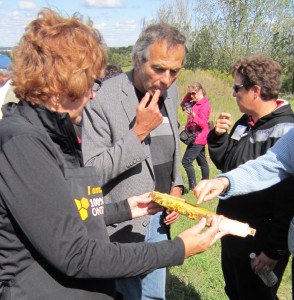 Regional Chair Carr tasting honey on a farm tour - better use of his time than getting his picture taken at a traffic intersection. Must have been a slow day at the office. Surely they have something better to do. If Friday is a slow news day someone might manage to get lost and actually get to the intersection and “marvel” at a traffic intersection. If the Regional Chair were offering a reception at the Regional Museum just up the road it might get a little coverage; news people are notorious for showing up at an event where the food is free and a bar that just might be open.
It appears that politicians are also notorious for doing whatever it takes to get their pictures in the paper.
The only newsworthy aspect of the event is that the round-about they want to have their pictures taken at was paid for with federal Infrastructure Stimulus Funding, of which Halton Region received $10.6 million towards the $16 million project that included the widening of Tremaine Road to four lanes, installing a water main and creating the Region’s first multi-lane roundabout.
The widening of Tremaine Road will improve the efficiency of Halton’s transportation network and maintain the safety of residents. This project provides the critical infrastructure and capacity in the road network for surrounding residential and employment lands in the rapidly expanding areas of central and west Milton.

 By Pepper Parr By Pepper Parr
BURLINGTON, ON November 16, 2011 The Region is responsible for garbage and waste collection and is going to introduce a tag day – and it isn’t what you might think it is. More of your tax dollars go to the Region than the city but that’s another story.
On Wednesday, November 16, Regional Council approved Halton’s new Solid Waste Management Strategy which will guide Regional waste management programs towards the goal of achieving a 65 per cent waste diversion rate by the year 2016.
While there are six to the strategy the one that is going to catch you eye is the requirement at some point in the future to put a tag on the fourth bag of garbage you put out. Fun, fun this one – so let’s cut to that chase right away.
 The face of things to come - Region approves policy that includes tags for garbage bags that go over the limit.  Word is that you will be able to buy the things in shheets of ten. We suggest having school crossing guards seol the things as a side line.. This is going to be the tough one. No word on quite when this will get introduced, exactly how much the tags will cost or where you will go to buy the things. The municipalities are clearly going to have to be part of this – no one is going to drive to Bronte Road for a couple of $1. garbage bag tags.
So how will I get a tag? Might have to trot down to city hall – oops they close pretty early and they aren’t open on the weekends.
Maybe I can call my council member. He might have a stash in his desk drawer. Maybe they will attach a tag or two to their campaign literature – Dennison (my council member) will get my vote for that courtesy.
Retailers won’t want to have anything to do with them but school crossing guards could set up a side line by keeping a pocketful of garbage tags and marking them up by 25 per cent – worth the extra quarter for me – because you know the day you need one of the things – you won’t be able to find it in the kitchen drawer, and it will provide a little extra spending money for the crossing guard.
Can’t ask the neighbour if he has one to spare; haven’t returned the Skill saw he loaned you a month ago because you broke the thing.
One of the more than a dozen Communication specialists employed by the Region advised me that with the policy now approved the thinkers in the garbage collection department will put their minds to this one and come back with rules and regulations that will guide us all.
These things take time to get put together – the bureaucrats should though be able to have it figured out by – say the summer of 2014, which is when you get to re-elect the rascals that gather around the city council table. There you go – an election issue.
Back to the actual strategy:
Halton Region began a public engagement process this past spring asking residents for their feedback on eleven potential waste diversion initiatives included in the Region’s Draft Solid Waste Management Strategy. The process included four open houses and a phone and web survey to make it easy for residents to provide feedback and have their say on the proposed initiatives.
“The previous 2006 to 2010 Solid Waste Management Strategy guided Halton Region through significant curbside program changes including the introduction of the GreenCart and weekly Blue Box collection which has led to single family homes diverting 60 per cent of their waste. According to Ontario benchmarking, Halton has the highest waste diversion rate in the province,” said Gary Carr, Halton’s Regional Chair. “By approving this new Solid Waste Strategy, Regional Council is continuing to support Halton as a provincial waste diversion leader in order to work towards a new waste diversion goal of 65 per cent.”
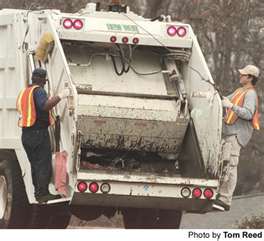 They don`t want to take more than three bags of your garbage - more than that and you will need a tag - that you will have to purchase. Resident feedback from the public engagement process supported achieving the new waste diversion goal of 65 per cent through the implementation of six key initiatives from the Draft Strategy. These initiatives have now been approved by Regional Council and will be put into place over the next five years.
1: Enhance promotion, education and outreach – increased promotion and education strategies include using social media, developing multi-media tools, developing a waste-less campaign and reaching diverse communities.
The Region believes that by educating citizens they will get a better buy in to the changes they need to make in the way they manage waste in Burlington, Oakville, Milton and the communities in Halton Hills
2. Enhance textile communications – expansion of existing textile diversion options for material such as clothing to capture more of this available material.
3. Enhance multi-residential waste diversion – enhancing Blue Bin recycling program and introducing GreenCart composting in multi-residential apartment buildings, engaging multi-residential community ambassadors and developing tenant/landlord recycling pledges.
4. Expand special waste drop-off events – introduce special waste drop-off days in areas not conveniently accessible to a current drop-off centre such as the Halton Waste Management Site.
5. Expand Blue Box materials and enhance Blue Box capacity – expand the list of eligible Blue Box materials to include additional items.
6. Decrease garbage bag limit and introduce bag tags – decrease the garbage limit to three bags/cans of garbage every other week. In order to place more than three bags/cans of garbage at the curb, residents would need to buy “bag tags” which typically cost $1 to $2 in other municipalities with similar programs.
It is important to note that 80 per cent of all houses currently place three bags or less of garbage at the curb.

 By Pepper Parr By Pepper Parr
BURLINGTON, ON November 14, 20111 Have you ever had one of those days where you were probably better off just staying in bed? That was sort of the situation with the unveiling of the “orchids” that were set up on Upper Middle Road immediately to the west of the railway underpass west of Appleby, which is a part of Burlington that is coming together quite nicely with all kinds of construction on Appleby Line.
There was to be a formal setting up of three large metal orchards which were part of a “public art” program. These three orchards had a price tag of just over $100,000. But that wasn’t the funny part.
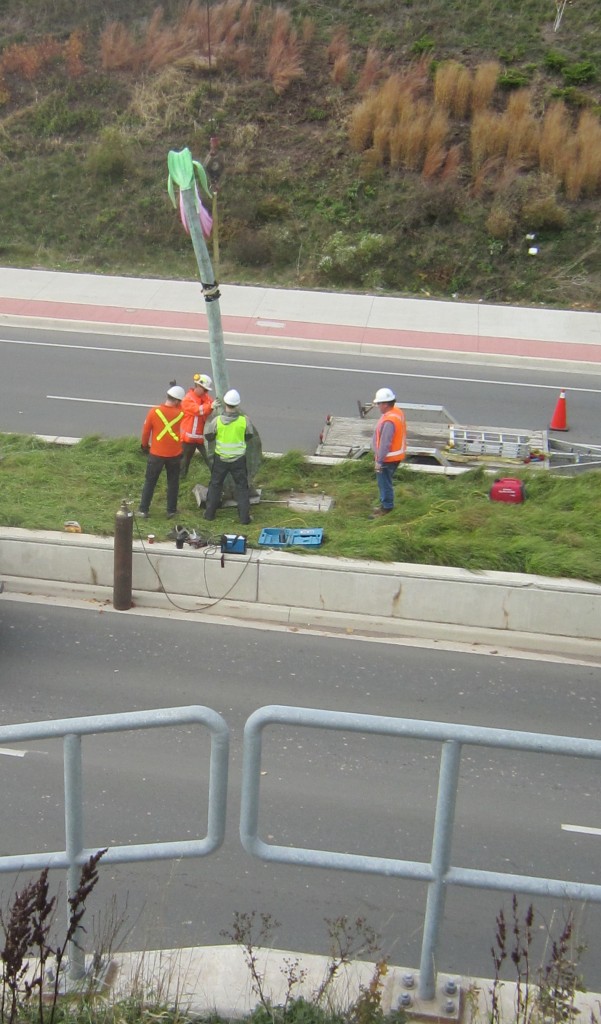 Orchids being `planted`on Upper Middle Road west of Appleby Line. They were originally to go up on November 9, but that date got pushed back to the 14th – Media were told there were some “transportation” issues. These things happens. The event was to take place at 1:00 pm and a collection of city councillors and staff were on hand to have their pictures taken with these three six-metre tall bronze and stainless steel sculptured orchids. Interesting bit of art and a lot more understandable than whatever it is they call it outside the Burlington Art Centre.
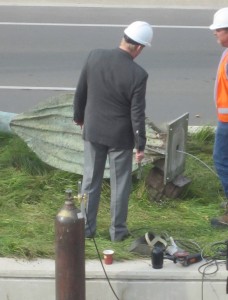 Councillor Sharman, with wrench in hand looks at the bolt holes - which weren`t quite large enough for the bolts. Ooops! On November 14th, the “orchids” were carefully taken off the trucks that were transporting them. The city had placed concrete pads in the ground with sturdy bolds that would keep the pieces upright and in place. We were told later that the bolts were 25 mm wide and that there were eight of the things for each orchid. It all looked pretty solid – however, when it came time to set the orchids on their bases – guess what? The holes in the base of the orchid that the bolts were to go through was only 20 mm wide. Ooops!
Someone had to get a drill real fast and make those hole bigger – easier said than done. The plates at the base of the orchids were more than an inch of steel thick. This was not going to be easy. But whoever was doing the actual work got it done – not all of it – but enough for the pictures to be taken and the first of the orchids went up and the photo-op types went back to their offices.
The three six-metre tall bronze and stainless steel orchids, painted in bright colours are installed near the underpass on Upper Middle Road. One can understand the intention, but the orchids are just a little difficult to appreciate by people driving their cars and there isn’t much in the way of pedestrian traffic in that part of town. A driver is on a road that dips down to go under the rail line and there really isn’t time to look up and appreciate the public art.
The intention was good – the placement of the art – not so good. Getting the art from Cork Ireland, where they were made, was almost as awkward as installing the art on Upper Middle Road.
Art and a community is never easy. There are still people in Toronto who don’t like the Moore sculptures in their city hall square. Art is very personal – it soothes or challenges your sense of taste – and is often confrontational and challenging; that’s what art is supposed to do.
Burlington engaged a company in London Ontario to handle the selection of an artist, thus getting the decision out of local hands, where there would have been all kinds of pressure for someone local. That was a good move and some informed, sophisticated people were involved in that process which went very well.
Burlington did all the right things with this project. They went international when looking for artists, and when the jury selected someone from Ireland, there was the expected noise from local people about not giving our own people a chance. Our own people do quite well internationally, thank you.
The work, done by Alex Pentek of Cork Ireland who won the competition over 50 other entrants, was more than a year in the making.
In 2010, artists from across Canada and other countries submitted Expressions of Interest to design public art to complement the Upper Middle Road median between Appleby and Walker’s lines.
Proposals were reviewed by an independent public art jury — which included practicing arts professionals and representatives from the local community. The city allocated $100,000, plus consulting fees, for the city’s first public art project meant to complement the Upper Middle Road grade separation — a $15.4 million project completed earlier this year.
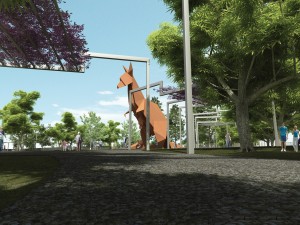 This design was shortlisted in an international competition for a landmark public sculpture overlooking Kangaroo Point, Brisbane, Australia. While not selected, this idea gained an underground following with its own anonymous web site: www.roozilla.com The Expression of Interest, or the call to artists, was advertised in several forums, including: the Community Planners, Inc.’s and City of Burlington’s websites; an e-mail sent by the Burlington Art Centre to all of its members; paid advertisements in Akimbo, a professional artists website, and the Burlington Post; requests to other Burlington arts organizations and Oakville’s and Mississauga’s arts councils to notify artists; as well as word of mouth.
One can understand why the jury looking into the work of the 50 artists that sent in submission to the Expression of Interest were excited when they saw the work of Alex Pentek. The artist has an international following and has done some hugely imaginative work that is quite exciting. Burlington just might become one of the few places in the world that has a “Pentek” .
The city budgeted $100,000 for the public artwork — which included the artist’s travel and accommodation in Burlington — is part of the $15.8-million project budget for the construction of the Upper Middle Road underpass. The commissioning of public art for Upper Middle Road is part of the city’s Public Art Master Plan of which the rather smart looking bicycle racks scattered throughout the city are also a part. Mostly local people did that work.
Beating out nearly 50 artists in Canada and internationally in a city-run art contest, the Cork, Ireland resident says he came across the project on the professional artist website Akimbo while in the process for looking for work internationally.
Pentek has been making large-scale and site-specific sculptures for 15 years and his works have ranged from a six-metre tall illuminated sculpture of a dandelion made from bronze and fibre optic cable to a 12-ton steel hedgehog — Orchids is his first Canadian-featured piece.
Once the pieces were completed and ready (earlier in October), they were transported in shipping crates from Cork to Antwerp in Belgium and then to Halifax, N.S. From there, they were sent to Brampton by train and eventually Burlington by truck, arriving last Friday (Nov. 11). Needing a day to inspect the pieces, Pentek oversaw the final installation of the three orchids..
When asked what he thought of Burlington, Pentek said he was happy to see a level of art appreciation in the community. “Coming from the outside, I see a very interesting community keen on preserving cultural heritage and encouraging the arts,” he said.
When news of the orchid sculptures was first released by the city last year and its selection of an international artist, several residents sent letters and comments to the Post explaining their frustration over the city not featuring a local artist for the project.
But Riley says residents have it all wrong. “I like the piece for its concept and its historical and geographical significance,” said Riley. “It goes beyond the mundane and it’s an excellent piece for Burlington.”
“It’s important to not only have local artists featured in our city, but we need to bring international artists here too,” he explained. “Not only will it diversify our culture, but it will also encourage our artists to go outside of our area and be recognized internationally — this is a key point our community doesn’t understand. It’s important for our artists to expand.”
Andrea Halwa, vice-president and cultural manager of the London, Ont.-based firm Community Planners Inc., was hired by the city to plan and implement the underpass art project as well as oversee the artist selection process. She has been the executive director for the London Arts Council for more than eight years, overseeing the administration of London’s community arts investments and public art programs.
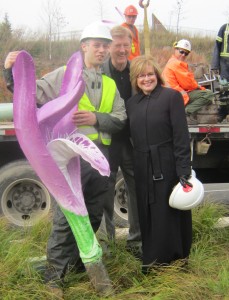 The Photo Op - Artist Alex Pentek on the left, displays a portion of the Orchid to Councillors Sharman and Lancaster She lists her extensive arts experience to include being “a professional member” of Americans for Arts and its National Public Art Network, as well as a loose knit group of public art managers across Canada. Halwa also has a teaching position within the arts management program at the University of Western Ontario.
It was this experience, Halwa says, that drew the interest of the Burlington-based Carrie Brooks-Joiner and Associates to contact her to act as an associate for developing the Burlington Public Arts Master Plan — and eventually why the city selected her to oversee the jury and artist selection process.
The jury consisted of Wayne Moore and Deborah Pearce, Ward 6 resident Scott Arbuckle and Brian Meehan, executive director and chief curator of Museum London in London, Ont.
When asked how the process worked, Director of Burlington Parks and Recreation, Chris Glenn, explained that “in this case Community Planners Inc., would have been charged with the selection process, which would have used a level of consultation from our staff, a member who was connected (to the project) at that time… they have since moved on,” Glenn said. “They would have had a dialogue with respect to number and type of person/artist that we would need with a certain skill set to align with the type of work in mind and… a bit of knowledge base of Burlington. They would then start to go through a process, to find some people and ask them to volunteer on the jury… in this case we were looking for someone with experience in bigger structures.”
We have cribbed extensively from the Burlington Post for this piece and want to include portions of an editorial they ran.
There was a lot of noise about the delays and the process that was used to select the artist – that’s all part of what a community is. Not possible to keep everyone happy. One of the local media certainly wasn’t happy with the choice of artist and let their provincialism show when in an editorial they said:
Surely we had a skilled sculptor living in Burlington who could have produced something as equally spectacular. If no one in Burlington was capable of taking up the challenge are we to believe that Canada does not have an artist talented enough to spearhead a special creation? But, no, our tax money was spent outside of the country.
Heck, we apparently don’t even have the expertise to set the art selection process in motion. That $20,000 job went to a London, Ont. company.
We know that art has no geographic boundaries. However, the city could have stressed the artwork must be made in Canada. What’s wrong with that?
Well just what is wrong with that? It is a very provincial outlook and not what the art world is all about. A number of Burlington artists are recognized world-wide and Burlington has, with the installation of the orchids recognized a world class artist.
Halwa made an important point when she said of the kerfuffle in local media: “It’s interesting, we have a very good working relationship with the media and our process for these types of programs is really transparent; I really hope that Burlington has adopted the approach for other public art projects as every project is going to have an artist that feels it should have been “his” project or “her” project or they could have done a better job, etc. The process we use has the jury making the decision and the jury is a mix of community folks, artists, arts administrators, etc. so it is not a process that can really be tampered with. Alas, ‘can’t win ’em all’ really applies here.”
The public got to here from the artist when Pentek spoke at the Burlington Art Centre about his work where he explained the importance of having public art that is unique and meaningful to Burlington during a recent meet-and-greet at the city’s art centre last Sunday.
“With a practice focused on making large-scale commissioned work over the past 15 years, as well as temporary gallery-based work, I’m very excited to work on a project that can create a sense of community through a legacy of shared experience,” Pentek said in an interview at the Burlington Art Centre, where he presented his design of three six-metre tall bronze and stainless steel orchid sculptures.
During his presentation to a room of nearly 20 people, the Irish artist did admit coming up with a design for the project had challenged him a bit.
 Pentek, the winner of the Burlington public art competition has always focused on outdoor work. An example of one of his pieces is shown above. “For one I couldn’t get great images of the site and number two, I have to admit, the site really didn’t inspire me,” he said. “The infrastructure was fully functional, but something had to go in here to lift it up.”
That’s why Pentek says he decided to go for a more colourful and realistic look to his orchids as opposed to a more metallic design.
“It would have been easier to work in monochrome, single-tone structures, but I felt that given where it’s going and the concrete around, the pieces needed to lift the area with vibrant colours,” he said.
The design for Pentek’s Orchids was loosely based on his previous successful work on the illuminated dandelion he did in Cork, he says, which used bronze and fibre optic cables.
Pentek researched various orchids from Burlington’s horticultural history and during a 2010-trip to Burlington, Pentek met with a Royal Botanical Gardens team to view pressed and refrigerated samples of flowers, as well as meet artist Georgian Guenther to view her smaller representations of orchids.
He finally settled on three orchids that were once native to Burlington, including the Cypripedium acaule, commonly known as Pink Lady’s Slipper, Arethusa bulbosa (Dragon’s Mouth), and Triphora trianthophora (Three Birds).
“It has been my aim to create this site specific work by celebrating the rich natural heritage of the local area through the diversity and delicacy of these wild orchids whose stillness and organic forms will visually complement the surrounding rail and road traffic infrastructure in an uplifting and light-hearted way,” Pentek said.
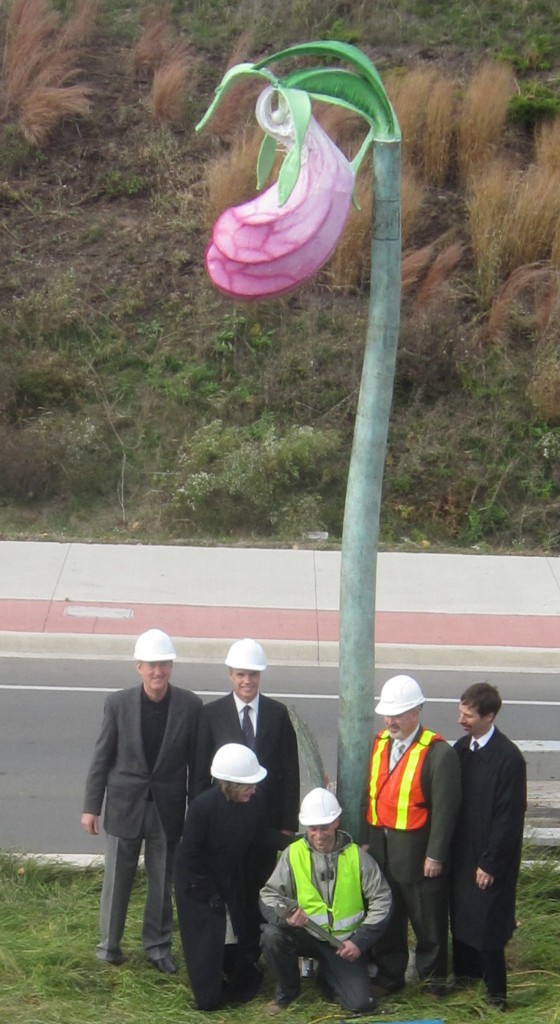 Civic officials and politicians gather around the $100,000 piece of public art. Can you name all of the usual suspects. The artist in the center holds the large wrench used to tighten the nuts on the bolts once the holes for the bolts were enlarged. Totaling six pieces, the orchid structures are made up of three bronze stems sealed with beeswax and three bulbs/flower tops.
Although the pieces are weather protected, Pentek says the stems may have to be touched up every year or so. The flower tops are painted with urethane paint, a strong, robust outdoor paint — which have been supplied to the city by the artist for any future touch-ups — and covered with a polyurea protective coating that Pentek says should withhold Canadian winters.
“I did not want to have them lacquered (a clear or coloured varnish) because if there was the slightest bit of movement, the paint on the pieces would crack,” he explained.
Pentek went on to assure his audience that the fibre optic and low-cost, low-maintenance LED lighting worked into the construction of the orchids will be more a subtle accent to the surrounding street lighting at night, rather than a distraction to drivers.
“It won’t be strong enough to illuminate the street on its own,” he said. “As you’re walking you’ll clearly see them lit, but you won’t be dazzled by them when driving.”
Pentek has been practicing as a full time artist both nationally and internationally since he graduated from the Crawford College of Art & Design, Cork, Ireland in 1996. He has focused on creating large scale site specific work, and has also made temporary gallery based works in paper and sound performances.
 Public art can be astonishingly attractive. This piece, done by Pentek is an example of his work. Burlington`s Orchids, will in time become part of the local scene. “I like to stay abreast of current scientific and mathematical theories, and elements of these inform my working practice on a practical and philosophical level. The study of light through Holography is an area of particular interest to me where information about the ‘whole’ is contained within each smaller ’part’ encoded by laser light interference patterns. I am also interested in the question of the emergence of life in Earth‘s early oceans, where complex systems achieved order not through top down commands but through a bottom up grass roots level of interaction. (Similar ‘passive dynamic’ systems can also be found working in today’s communities in the natural world, from ant colonies to the formation of modern cities). I enjoy exploring these holistic and interactive ideas, which are relevant to the relationship between ‘self’ and the surrounding ‘community’ and World in which we live.
“While the ideas behind each work vary greatly, the work is interpreted just as differently and validly by all who experience it. It is my aim to create openly challenging and engaging work that not only explores different themes and ideas but that also communicates on a more primary visual level.”
The key word there is “challenging”; that is what art is all about. Artists bring what is possible to us; they force us to look at things differently and while that may make us a bit uncomfortable it also enriches the mind and the spirit.
 Not all of Pentek`s work is displayed outdoors. This paper mobile has an evocative look and feel to it. “As I mainly make large scale permanent work, the processes behind realizing any project are an important part of the work. Using my own set of skills as an artist where possible (such as drawing and sculpting / casting in various materials); I enjoy the challenge of working to a large scale by drawing on the skills and expertise of architects, engineers and fabricators to realize a project. Also, often introducing an idea to the local community through public consultation, communication and people skills become important to the success of a project as well as expertise in the finished material of the work itself.”
Our Mayor, in his press release said: “Burlington is an innovative and progressive community, built upon a strong sense of community pride. Public art projects like Orchids help give shape to that pride. We’re excited to see such an impressive art project come to life.”
The public chatter overt the Orchids just might move The Pier off the front pages for the Pier will eventually get built band it will be loved by all – but those orchids will stick in the craw of many for a long time. Fortunately the artist lives in Ireland and he won’t have to put up with all the noise. The Mayor makes an important point when he says public art helps give shape to who we are – it also draws out comment that – well perhaps the words were better left unsaid.
Are the Orchids good art? That’s for you to decide. They just might grow on you.

 By Pepper Parr By Pepper Parr
BURLINGTON, ON November 13, 2011 For former Governor General Adrianne Clarkson there was no such thing as a short answer and if you were into great detail from an informed and knowledgeable speaker who was there right on the front lines, then you would have enjoyed the talk given by Clarkson at the Royal Botanical Gardens last Sunday afternoon. Some 150 people were on hand to hear what she had to say about the ten people she wrote of in her most recent publication, Room for all of us, which is the story of ten people who immigrated to Canada and the contribution those ten have made to the welfare of the country.
Clarkson argues that we are a richer and at the same time more complex country because of our approach to immigration, which, she pointed out is, significantly different than that of other countries. In Canada` she explained `we expect the people who arrive as landed immigrant to become citizens and some 80% of them do, which is the highest percentage in the world. The Australians percentage is about 75% while in the United States around 55% of those who arrive as immigrants eventually become citizens.
In Europe, added Clarkson, landed immigrants cannot become citizens. They are in a country as workers and when they are no longer needed they are forced to return to the country of origin. Clarkson told of a housekeeper she had in Paris where she served as Agent General for Ontario. The woman had been in France for more than 30 years but could have been told to leave the country with just 24 hours’ notice.
The former host of CBC programs the Fifth Estate and Take 30 certainly knew her subject and she entertained her audience for well over an hour before she sat to autograph copies of her book.
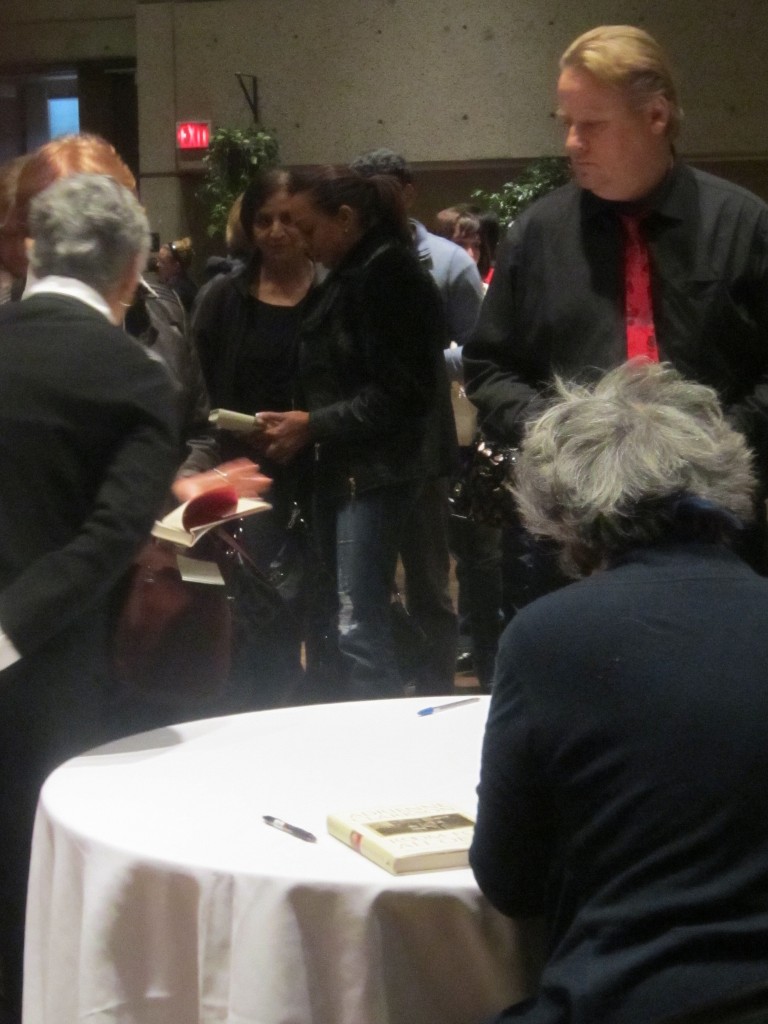 Burlingtonians line up to have their books autographed by former Governor General Adrianne Clarkson. Clarkson, whose family immigrated to Canada from Hong Kong and settled in Ottawa knew what it was to be an immigrant and told her audience of the less than honourable past of Canada`s immigration policy `We were no better than many of the others when we interned our Japanese citizens during the Second World War or turned back a ship loaded with Jews during that time as well.
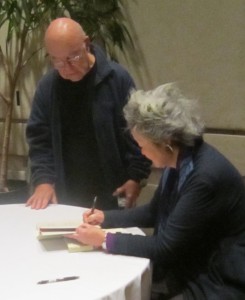 Clarkson at RBG book signing where she spoke of her immigrant experience and the contribution immigrants make to Canadian society. Canada has changed significantly since that time and the waves of recent immigrants included men who did not want to serve in the Vietnam War and the thousands of Vietnamese Boat people who came to this country. Tamils have come to this country as well, and each time a wave of immigrants arrives this county accepts them and they integrate and become a part of who we are today. Clarkson believes we are a stronger and better country because of our immigration policies.
It was the story of these people that Clarkson wanted to tell. Of the ten people in the book she knew five personally and two others were friends. Ì had to find the other three ‘explained Clarkson.
Clarkson passed on an interesting fact that few probably realized about the Boat People. The federal government at the time agreed to admit 25,000 people and local church groups clamored to be able to bring in more. The government agreed and said that if Canadians were prepared to sponsor more and put up $2500. per person then more could be admitted – and Canada eventually brought in 150, 000 boat people who quickly became part of the Canadian fabric.
Her audience learned more about what immigrants have done to and for Canada than most knew when they walked into the room. In the very early 1900`s we brought in 20,000 new people and we know bring in 300,000 every year and they all eventually fit into the country and add to what we are.
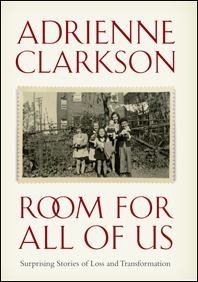 Former Governor General Adrianne Clarkson spoke about her book at an RBG event on the weekend. The Canada we are today explained Clarkson is much, much different than the Canada she came to in 1942. Clarkson is the first immigrant and refugee to become Governor General of this country. We have indeed come along way and after listening to Clarkson one can begin to realize, understand and appreciate the contribution immigrants have made to our country.
Upon leaving the Office of Governor General Clarkson, along with her husband formed the Institute for Canadian Citizenship that engages Canadians in citizenship through innovative programs, campaigns and partnerships designed to ensure new citizens are welcomed and included as equals, to create meaningful connections among all Canadian citizens, to foster a culture of active, engaged citizens and to celebrate what it means to be Canadian.
And that is exactly what Adrianne Clarkson was doing on a Saturday afternoon in Burlington at an event sponsored by A Different Drummer, a Burlington bookstore.

 By Staff By Staff
BURLINGTON, ON November 12, 2011
Going out on a high note is the best way to leave the stage – which is what Mayor Goldring is doing with his Inspire series when, Andre Picard, Health reporter and columnist for the Globe and Mail will be the featured speaker at the last of the 2011 series the Mayor instituted during his first year in office.
Attendance has been good and it will grow as people get used the idea of speakers coming to Burlington with new ideas that stimulate and offer new and different perspectives and begin to recognize the quality of the speakers the Mayor is bringing to the city.
The series started with Christopher Hume, Architectural reporter and columnist for the Toronto Star who told his audience that McMaster University`s behavior in the way they handled building of their Burlington campus on the South Service Rd., was a moral outrage. There was no doubt in his mind where he stood on all this.
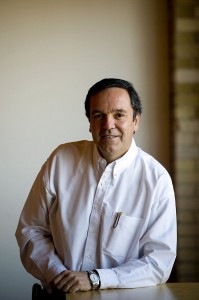 Gil Penalosa was the second featured speaker in the Mayor's Inspired series. That was followed by Gil Penalosa, a passionate advocate for improving quality of life through the promotion of walking and bicycling, and of parks, trails and other public spaces as great places which foster vibrant cities with healthier communities and happier residents.
Penalosa earned a Master in Business Administration (MBA) from UCLA’s Management School. Following years of private and public sector senior managerial experience, the Mayor of Bogotá, Colombia (pop. 7 m), appointed him Commissioner of Parks, Sport and Recreation for the city.
Penalosa led his team to design and build over 200 parks, of which the best known is the Simón Bolívar (360 hectares). They were also successful in opening 91 kilometres of car-free city roads on Sundays, the Ciclovia, where over 1.3 m. people come out weekly to walk, run, skate and bike. They also created the Summer Festival, with over 100 events in 10 days and more than 3 million people attending and since the first year has become the main recreational event in the country.
 Tom Rand, author of Kick was the third speaker in the Inspire series. He advocated ways to reduce our carbon footprint. Penalosa was followed by Kick author Tom Rand, a successful software entrepreneur who survived the dot com bubble in 2000. Rand now focuses his efforts on carbon mitigation and is active in Cleantech venture capital, technology incubation and commercialization plus public advocacy. Rand is the Cleantech Practice, Lead Advisor at the MaRS Discovery District in Toronto and sits on the board of a number of clean energy companies and organizations, including Morgan Solar.
One speaker was on the platform the night of an NHL playoff game – but the crowd was still good – in the 150 + range.
The series have in the past been held at the Ron Joyce Centre of the McMaster DeGroote School of Business on the South Service Road. The Mayor has decided to keep the business in the family and this last event for the 2011 series will take place in the Community Theatre of the Burlington Performing Arts Centre. The event starts at 7 pm – the Mayor`s office likes to get a handle on possible attendance – the room holds just over 200 people.
Now – the speaker – Andre Picard.
Picard is the Globe and Mail’s public health reporter and columnist who was recently named the Conference Board of Canada’s CIBC scholar-in-residence.
The program has funded scholars since 2005, enabling them to carry out research on issues that resonate throughout Canada. Picard’s research topic is The Path to Health Care Reform: Policy and Politics.
“He’s the top health journalist in the country,” said Anne Golden, president and CEO of the Conference Board of Canada. “He’s able to cover both the policy issues and the politics because he’s been so engaged on the whole range of issues around all our health-care systems.”
The College of Family Physicians of Canada named Picard a recipient of its 2011 CFPC/Scotiabank Family Medicine Lectureship Award.
Mr. Picard has been recognized for years as one of the country’s top public policy writers. His books, Critical Care: Canadian Nurses Speak for Change and The Gift of Death: Confronting Canada’s Tainted-Blood Tragedy, were best-sellers.
Among Mr. Picard’s previous awards are the Michener Award for Meritorious Public Service Journalism, the Canadian Policy Research Award, the Atkinson fellowship for public policy research and the Centennial Prize of the Pan American Organization. He was named Canada’s first Public Health Hero by the Canadian Public Health Association and was honoured as a champion of mental health. He is a four-time finalist for the National Newspaper Awards.
Picard said being named the CIBC scholar-in-residence at the Conference Board will give him new opportunities and called it “a nice challenge.” “This one allows me to do some journalism – some long-form journalism,” he said. “It allows you to do the work that you usually do but in a different way and more in-depth.”
In a recent column Picard had this to say:
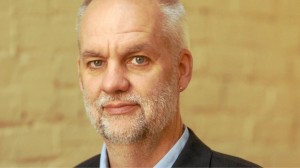 Andre Picard, Globe and Mail columnist and perhaps the most prominent speaker the Mayor has brought to Burlington. His views on our health system may include some comments on the Joseph Brant Memorial Hospital. He will be a very direct speaker. One of the fundamental structural problems in Canada’s health system is the lack of a clearly identified front door.
Put another way, there is no place where patients can routinely go to access the care they need promptly and efficiently and that tracks them throughout the health-care “journey.”
Traditionally, we have depended on family physicians to serve as that home base. Almost 30 million Canadians have a family doctor, but roughly four million others have none. Still, even for those with a regular caregiver, prompt appointments are hard to come by and same-day access – the gold standard – is a rarity.
So the de facto entry point into the system all too often becomes the emergency room (where patching and dispatching, and long waits, are the norm) or walk-in clinics (tremendous money-wasters that specialize in passing the buck back to ERs or family doctors).
Using these inappropriate points of access is the equivalent of entering your home by clambering up the fire escape or crawling in through a basement window, only to find that the door into the main floor is locked and you have to start over again.
It’s a terribly inefficient and expensive way to deliver health care. Among other things, when there is no front door, there is no real gatekeeper and, with the proliferation of ever-more-expensive drugs and technologies, the gatekeeper function has become more essential than ever.
Worse yet, regardless of what door patients use to enter the health system, there is little continuity in their care.
One of the principal reasons for this disjointedness is the lack of electronic health records. If someone has a heart attack and ends up in the ER, or is prescribed antibiotics at a walk-in clinic, or gets to see a specialist, his or her family doctor is unlikely to know.
This situation is not new.
 The Inspire Series is one of the best things the Mayor has done for the city. It ranks right up there with his decision to tough it out and continue with the building of The Pier. Primary health reform has been talked about for decades. In fact, with the publication of the Lalonde report, a ground-breaking document prepared by health minister Marc Lalonde in 1974, Canada became a world leader in the concept of primary care (but sadly not in the practice.) Every one of the dozens of health commissions since has dedicated a good chunk of its recommendations to the need for primary-care reform.
In the 2004 Health Accord, the provinces received $800-million to bolster primary care, but it was overshadowed by the politically motivated focus on reducing surgical wait times, where billions were invested to produce modest results.
The good news is that there has been a lot of progress of late on the notion that every Canadian should have a clearly identifiable primary-care provider for preventive care, sickness care, and some quarterbacking and follow-up when a patient needs acute care.
In the 21st century, this kind of care can’t be provided by a single physician à la Marcus Welby.
Today’s patients require episodic care occasionally, but mostly they need chronic care. Consider that 81 per cent of people over the age of 65 have at least one chronic health condition such as heart disease, diabetes, chronic obstructive pulmonary disease, etc. For the most part, they need a team to provide health care, not a single physician.
Thankfully, in recent years, there has been a significant shift to providing primary care using interdisciplinary teams. Alberta has Primary Care Networks; Ontario has Family Health Teams; Quebec has Family Medicine Groups and; most other provinces have variations on these names with similar philosophies.
We shouldn’t forget either that excellent primary care has been offered for decades by CLSCs (community health clinics) in Quebec and Community Health Centres in Ontario, but these pioneering initiatives have always been chronically underfunded.
But the process needs to be accelerated and valued. And, practically, that means shifting resources from acute-care hospitals to community-based primary-care practice.
 Picard is a prolific writer who works from his home in Montreal as the Globe and Mails Health columnist. He has been given some very significant awards for his work. The notion of creating a clear front door into the health system got a significant boost recently in a report from the College of Family Physicians of Canada, which represents the country’s 35,000 family doctors. (Canada has another 34,000 physicians in specialties other than family medicine.)
The CFPC calls for a model that has as its foundation a concept called the “Patient’s Medical Home.” The PMH is described as a family practice that serves as the “central hub for timely provision and co-ordination of a comprehensive menu of health and medical services patients need.”
The PMH is, naturally enough, centered around the family doctor (after all that’s who the CFPC represents), but, to its credit, the group fully embraces the need for interdisciplinary care, the belief that a patient requires a team or network of caregivers, including nurses, pharmacists, physician assistants, and other health professionals, located in the same physical site or linked virtually from different practice sites throughout the community.
The report also makes some key points that are not emphasized nearly enough in our continuing discussions about health-care reform. To wit:
The foundation of good healthcare is good relationships between providers and patients, and among providers;
Timely access to both prevention and treatment is an essential component of good health care, and Canada’s waits are among the worst in the world;
Patients themselves need to be active participants in their care. They need to take responsibility, not just be passive recipients of care;
Continuity of care has to be a priority because it is in the transitions – from the family doctor to the specialist, from the ER to the ward, from hospital to home, etc. – where all the bad things happen.
In Canada, we have a terribly knee-jerk reflex when responding to problems: We throw more money and bodies into doing more of the same, no matter how inefficient.
With primary care, the opportunity for reform lies in actually doing things differently and ensuring that patients have access to the right care, at the right time, from the right professional.
That can’t even begin to happen if there is no front door, no medical home for them to call their own.
Burlington is in for a treat. The Community Room at the Performing Arts Centre has seating for just over 200 people – this could be a SOLD OUT event, which by the way is free.


By Paddy Torsney
BURLINGTON, ON November 11, 2011
It is fitting that I write this review of Room for All of Us by Adrienne Clarkson on November 11th. Like many Canadians, I spent the morning at Remembrance Day ceremonies in my community. My parents are immigrants to Canada so we don’t have uncles, aunts and grandparents to remember. In fact, my parents came from Ireland, a country that remained neutral during the war and they did not serve in the two world wars.
This morning the Minister who spoke used the theme “I remember it well”, expanding the notion to remember the lost and injured soldiers and civilians, to experience through his stories the suffering of the times.
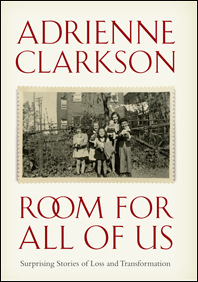 Mme Clarkson’s book encourages readers to do just that: remember it well. Remember the stories of the individuals she presents to us and remember how their journey is similar to ours, or our ancestors, and that whether they came in 1999 or in 1799, the stories have similarities. Though the distance, nationality and skin colours may be different, in our hearts we are all the same: courageous people who have chosen, or been driven to choose, Canada. Even more importantly, we need to remember that our nation is richer for each of the experiences. Mme Clarkson’s book encourages readers to do just that: remember it well. Remember the stories of the individuals she presents to us and remember how their journey is similar to ours, or our ancestors, and that whether they came in 1999 or in 1799, the stories have similarities. Though the distance, nationality and skin colours may be different, in our hearts we are all the same: courageous people who have chosen, or been driven to choose, Canada. Even more importantly, we need to remember that our nation is richer for each of the experiences.
Mme Clarkson chose ten Canadians to profile in her book. Their backgrounds are diverse and most of them faced diversity before choosing Canada. Each and every one of the people she presents had an interesting story to tell. Each and every one caused me to learn more about what Canada and the world was thinking at the time of their arrival – anti-Vietnam protests, Idi Amin’s expulsions, destitute boat people from Vietnam and Sri Lanka, the Holocaust. Although the circumstances are different, there are many similarities to more recent migrations and migrations further in the past.
The book is well researched and the stories well woven with Clarkson`s experience coming to Canada as a young Chinese girl and settling in the Ottawa of the 1940’s. This tapestry of stories and history allows readers to feel, and be inspired by, the wonderful nation building that is occurring with each arrival this year as some 250,000 new entrants join our country.
Former Governor General of Canada, Mme Clarkson’s legacy project is The Institute for Canadian Citizenship. It’s a great project that ensures more Canadians will learn our country’s rich history, a history that comprises dynamic people and remarkable journeys. This book will help launch that Institute to many readers.
I can recommend this book to readers. While readers will be familiar with some of the public figures presented (Calgary Mayor Naheed Nenshi, MP Rathika Sitsabaiesan, former MLA Corky Evans, radio star Andy Barrie and Rogers Canada president Nadir Mohamed), there are other people many Canadians won’t know well (Holocaust survivor Fred Bild, film director John Tran or artist Tamara Toledo, author David Albahari). With each story we learn more about the people and become interested in their journey and how their experiences have influenced careers and life choices.
 Former Governor General Adrianne Clarkson has written a book consisting of profiles of people who chose Canada. For those of us who were born here, the book offers a view of our country that is both refreshing and rewarding. The Blair family story presents another perspective on the decision to choose Canada. The Blairs descend on both sides from ancestors who arrived in Canada in 1843. After generations of life in Quebec City, the family moved to the UK for professional reasons but kept their children connected with Canada in stories and summer vacations. After years abroad, all three children returned to live in Quebec City as bilingual citizens who care deeply about their country and have put enormous effort into preserving Quebec’s historical buildings. “The Blairs are now part of only two percent of the Quebec City population, whereas their ancestors (British) formed fifty percent. But they have adapted. They have done what they wished to do: live in the society of their ancestors and adapt to the changing conditions.”
The Blairs represent well the story of Canada: people coming to our shores and making and remaking our nation through the centuries. And we are all enriched by these experiences, whether or not they are part of our family.
Mme Clarkson presents the ten stories in a context which is interesting and informative. Her emphasis on history made me long for more! I think this book would be an interesting addition to the school curriculum.
I had a high school teacher who once told me Canadian history was boring. These stories and Ms Clarkson’s presentation of our history were engaging and important. As she says at the end, “When Canada adopts you, you are part of the whole family, with its benefits and its dysfunctions, with its birthday celebrations and crazy Uncle Herb”. And further, “If our presence is to have meaning in our chosen country, we must all of us accept all of our history. Our history must be taught and absorbed; our experiences, bad and noble, must be shared.”
I know I’d like to give a copy of this book to one of my teachers (Mr. H) with an inscription inside the book – for you Mr. H., Mme Clarkson’s book is inspiring, interesting enjoyable and anything but boring.
Paddy Torsney is a member of the Privy Council and served as the Member of Parliament for Burlington. Room for All of Us by Adrienne Clarkson is published by the Penguin Group in Canada and is available at The Different Drummer in Burlington.
Mme Clarkson will be reading from her book at a public event at the Royal Botanical Gardens at 2:00 pm on Sunday November 13th.

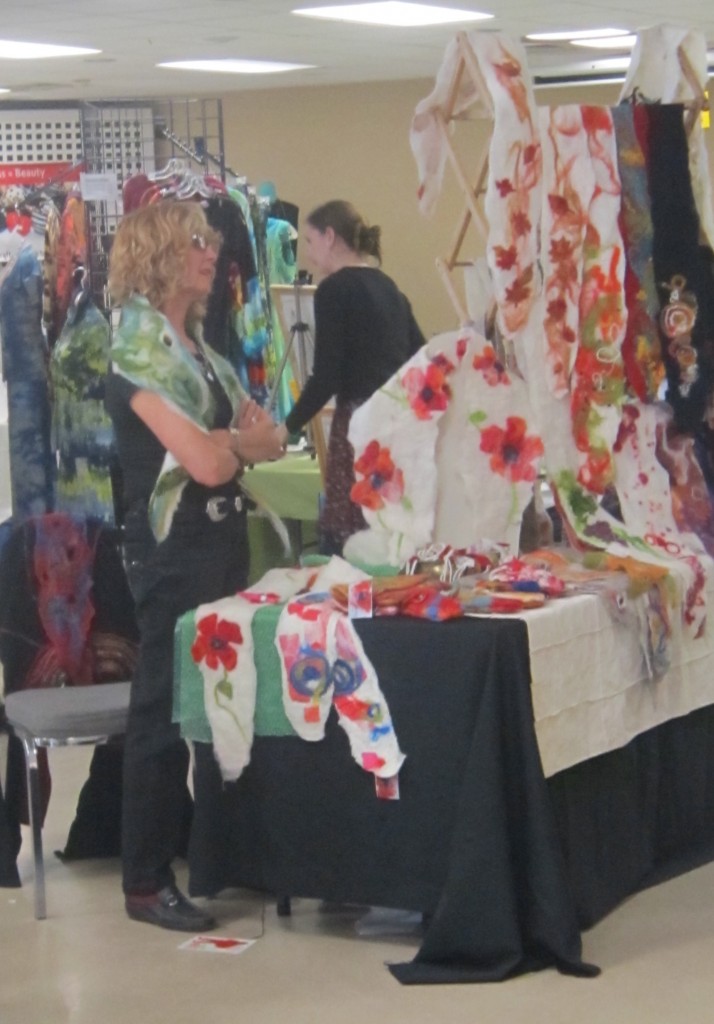 Wearable Art event a success at Burlington Art Centre. By Staff
After a very successful Wearable Art event the Burlington Art Centre now moves into its Christmas Season and will begin with the always popular Soup Bowl event and the annual Christmas Sale.
Wearable art attendance held up – basically the same as last year according to Sandra Baker Director Marketing and Development for the BAC, and artists were generally pleased with their individual sales. It was certainly a colourful event.
The Soup Bowl, an always very popular event – so much so that the Thursday and Friday, 17th and 18th noon events, are SOLD OUT – and when we make that statement said Baker – we mean it. Those days are sold out.
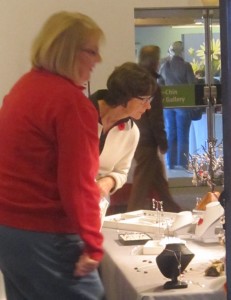 The selection was excellent and the buyers were curious - and sales were good. Saturday and Sunday still has some room – but move quickly if you want to participate in this event where you choose a fabulous handcrafted bowl, fill it with a choice of gourmet soups made by local restaurants. Add delicious salad, a roll, coffee and dessert for a great meal! The bowl you choose is yours to keep! All sittings have a cash bar. $35 BAC Members; $40 non-members; Reserved Table of 8: $275; Tickets and information: at the BAC; online: theBAC.ca/soup or 905-632-7796, ext 326 Remember – just Saturday and Sunday are open.
The Annual Christmas Sale event will have 95 artisans taking part this year. The event runs from
November 17, 11 am – 3 pm;
November 18, 11 am – 9 pm;
November 19 and 20, 11 am – 4 pm
Free admission and parking.
.

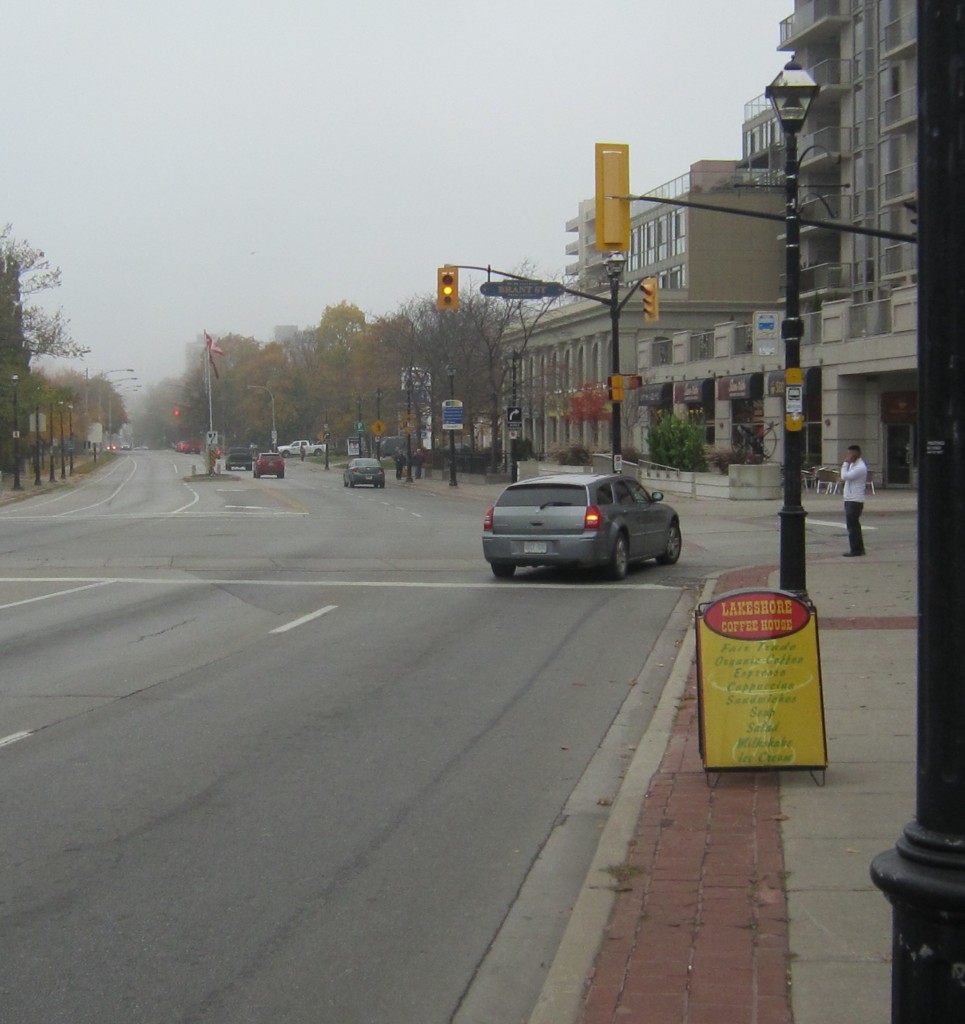 Eva Amos, a Burlington resident would like to see stronger traffic controls along the Lakeshore, especially at Brant and Maple where she feels the right hand lanes are used by aggressive drivers to rush ahead of the traffic flow. She thinks making those right hand lanes, right hand turns only.  By Eva Amos By Eva Amos
BURLINGTON, ON November 11, 2011 –The concern I have and have been expressing to council for years now, since Lakeshore Road was reconfigured in the downtown core is the bottleneck this has created in the core and especially the aggressive driving behaviour of many drivers in this particular area. The reply I get most often from council members is that Lakeshore is not a highway and the intent is to slow traffic through the downtown. This is all very commendable but in my opinion this configuration does nothing but cause road rage and encourage aggressive driving behaviour.
As a driver I have been cut off too many times to count, by the aggressive driver roaring up the curb lane, just to get in ahead of the long line of drivers, patiently waiting in the middle lane, as the signage instructs us to do. Putting signs up and painting some lines on the road simply doesn’t work. Most drivers do stay in the through traffic lane but at every light change there is the driver(s) waiting to beat the traffic and put the rest of us at risk. This to me is like saying most drivers stop at a red light, only a few run them. This is not OK. It is not a speeding issue. It is an aggressive driver issue, which I thought we were trying to cut down on.
If the configuration is to remain, which it seems it will, let’s make some changes to the traffic flow. Some suggestions I have made but have gone unanswered are: make the curb lane going westbound at Brant and Lakeshore a right turn lane only. This would allow the driver, patiently waiting to turn right at Brant, but stuck behind the driver waiting to roar up the curb lane to cut off the through traffic, to make his turn, thus taking the aggressive driver out of the lane. The same could be done at Maple and Brant coming eastbound.
Also make it a no right turn on red at Brant and Lakeshore. Also at Maple and Lakeshore, turning right. Again the aggressive driver is in no position to come up the curb lane when traffic is coming through. This would all slow traffic down I realize, but isn’t that the intent of council. It would certainly make it safer for all. Drivers, pedestrians and cyclists.
It is my understanding the engineering department has recommended the configuration remain until 2019. I understand from an earlier e-mail from Jack Dennison that council would probably review this recommendation in 2011. It is now November 2011. I don’t think it
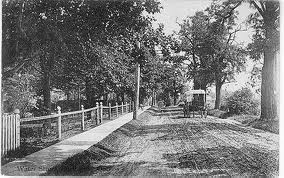 There was a time when Lakeshore was known as Water Street and traffic was a little slower. But Burlington isn't a sleepy little town anymore - traffic has to be controlled. has or will happen this year.
I am not suggesting Lakeshore Road should go back to 4 lanes, although this could be done with parking meters put along this stretch of roadway, with parking only in off peak hours.
This would add some much needed parking in the downtown core and add some revenue for the city. It seems to work well in Oakville.
Ideally we would get everyone on transit and bikes but the reality is, this is not going to happen. We are not a sleepy little town anymore. We are a big city with a large population. Let’s try and get our residents around safely.

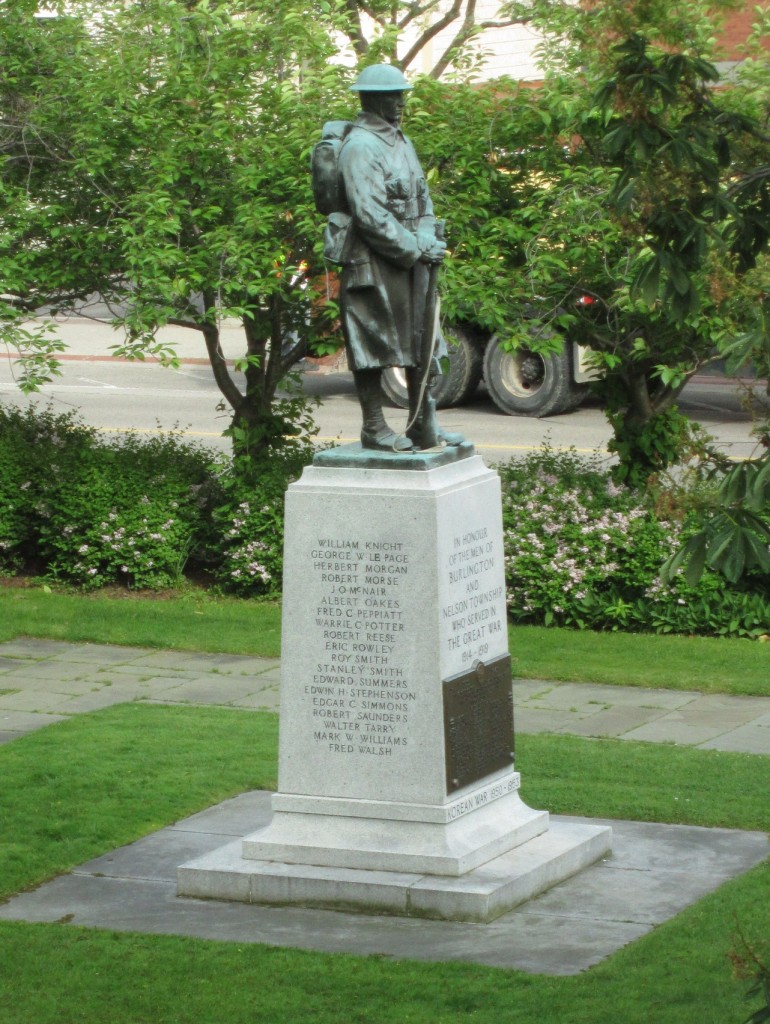
They shall grow not old, as we that are left grow old:
Age shall not weary them, nor the years contemn.
At the going down of the sun and in the morning
We will remember them.

 By Staff By Staff
BURLINGTON, ON November 11, 2011 Between August 29th and September 10th, five nail and hair salons on Plains Rd, in the area of King Rd were broken into. In each incident the front door was smashed to gain entry. Small amounts of cash ranging from $10 to $100 were stolen. In one of the break and enter, a 42 inch LCD television was taken.
This type of petty crime is often the result of drug addicts looking for something easy and can be a signal that there are concerns about safety in the community.. The police know how to handle this type of situation but they need your eyes on the street. Be vigilant.
Anyone with information on this or any other crime is asked to call Crime Stoppers at 1 800 222-8477 (TIPS) or through the web at www.haltoncrimestoppers.com or by texting “Tip201” with your message to 274637 (crimes)

|
|
























































































